Analyzing Leadership and its Challenges at Sultan Qaboos Air Academy
VerifiedAdded on 2023/06/15
|26
|2068
|495
Report
AI Summary
This report analyzes the leadership challenges at Sultan Qaboos Air Academy in Oman, focusing on identifying leadership styles, challenges, and their impacts. It explores various leadership styles such as transactional, transformational, and laissez-faire, and examines challenges like ineffective managerial procedures, employee skill development, and team politics. The research employs a deductive approach with survey and observation methods to gather data from air academy personnel. The findings highlight the prevalence of autocratic and democratic leadership styles and the impact of these challenges on the academy. The report concludes with recommendations for mitigating these challenges through proactive leadership, delegation, and strategic decision-making, suggesting future research should incorporate implications and concepts from existing leaders.
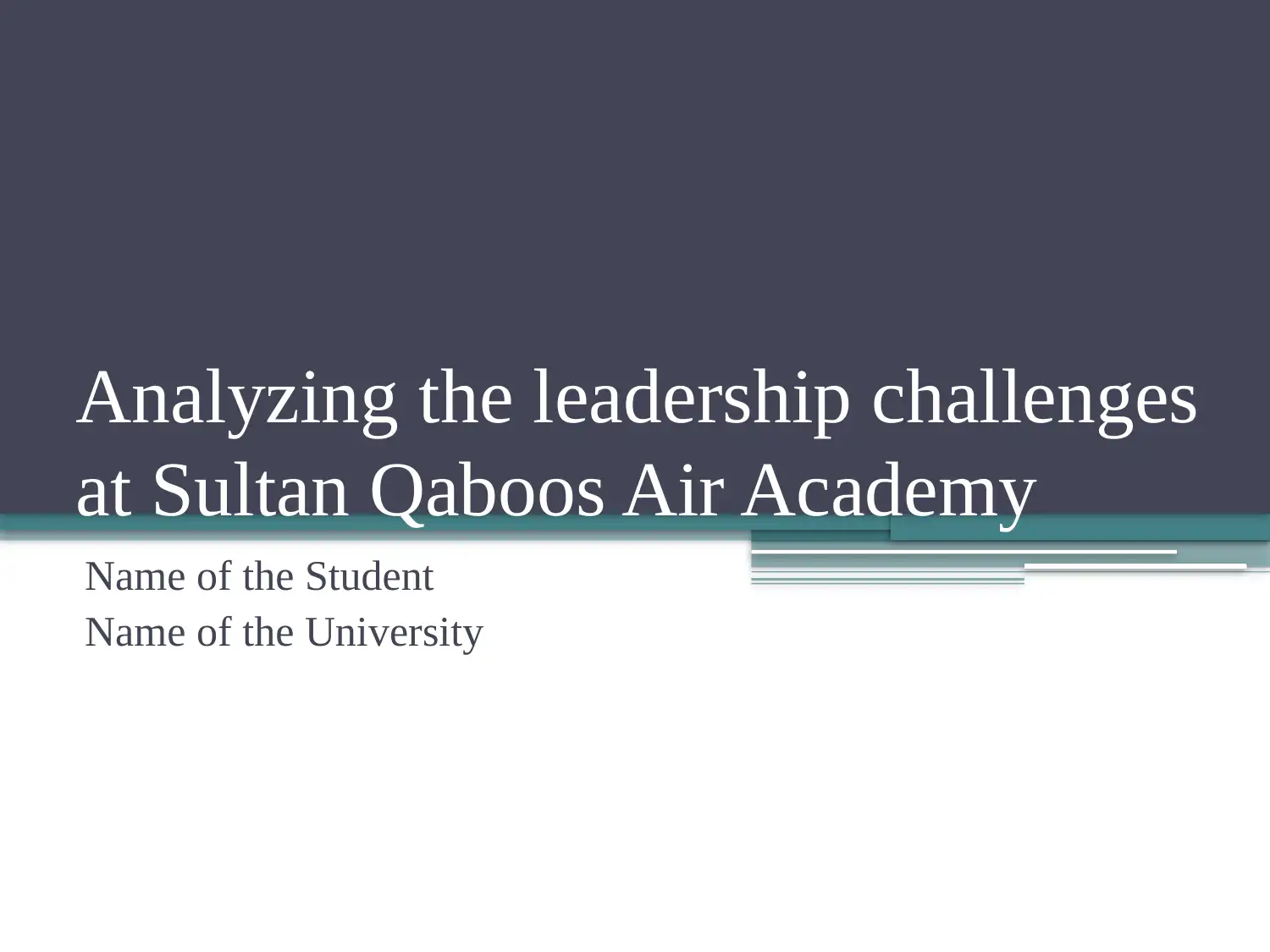
Analyzing the leadership challenges
at Sultan Qaboos Air Academy
Name of the Student
Name of the University
at Sultan Qaboos Air Academy
Name of the Student
Name of the University
Secure Best Marks with AI Grader
Need help grading? Try our AI Grader for instant feedback on your assignments.
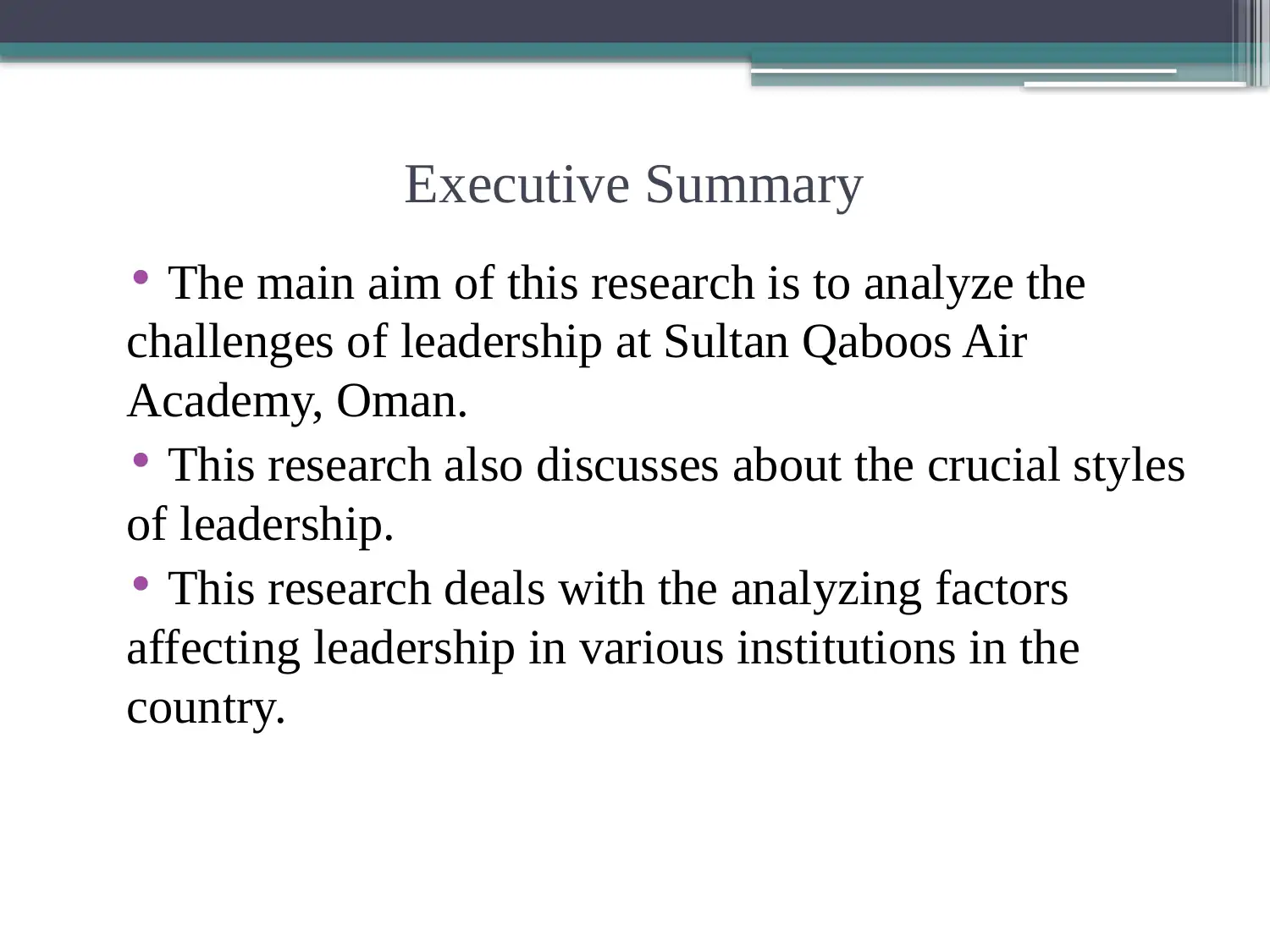
Executive Summary
• The main aim of this research is to analyze the
challenges of leadership at Sultan Qaboos Air
Academy, Oman.
• This research also discusses about the crucial styles
of leadership.
• This research deals with the analyzing factors
affecting leadership in various institutions in the
country.
• The main aim of this research is to analyze the
challenges of leadership at Sultan Qaboos Air
Academy, Oman.
• This research also discusses about the crucial styles
of leadership.
• This research deals with the analyzing factors
affecting leadership in various institutions in the
country.
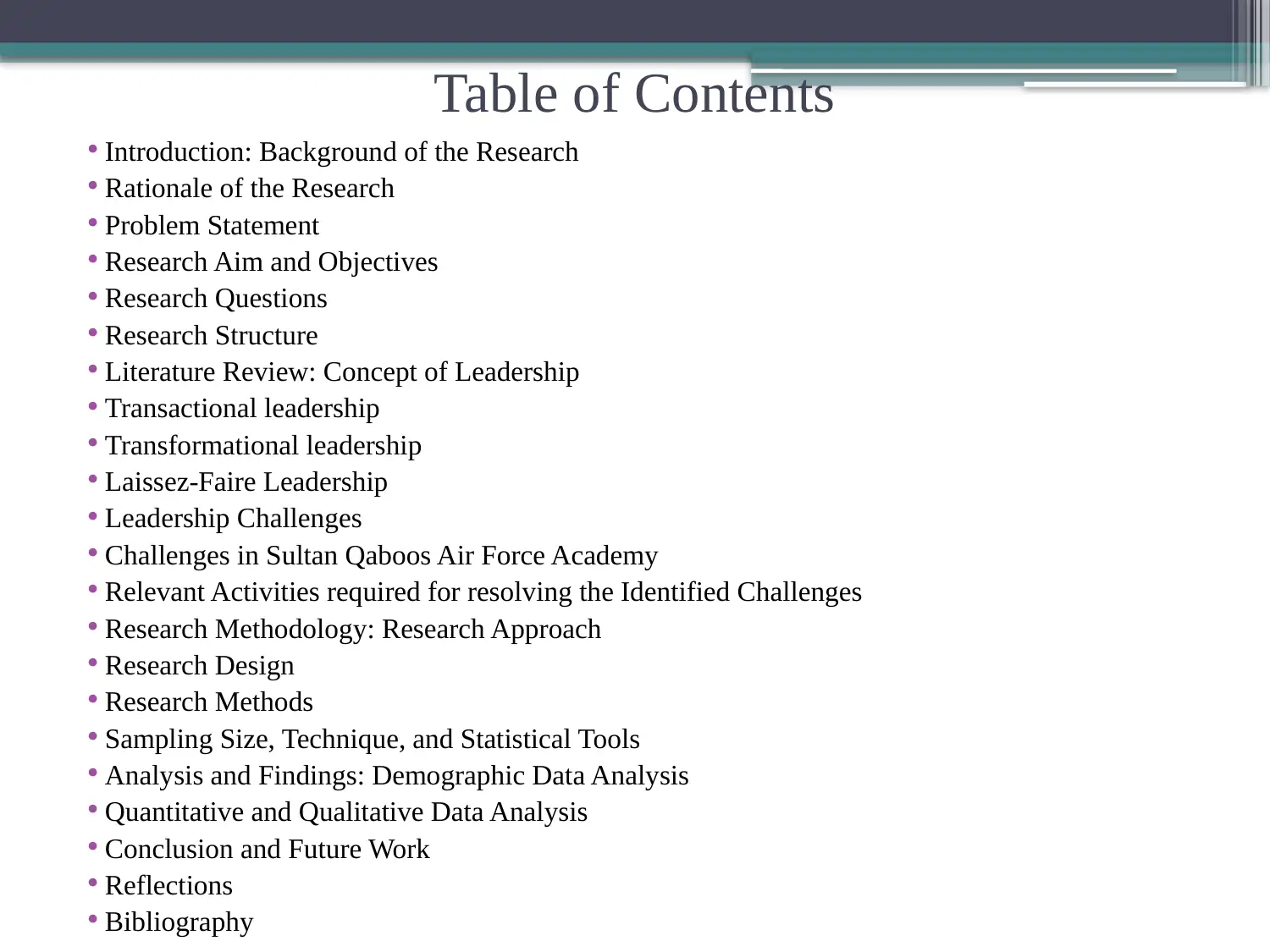
Table of Contents
• Introduction: Background of the Research
• Rationale of the Research
• Problem Statement
• Research Aim and Objectives
• Research Questions
• Research Structure
• Literature Review: Concept of Leadership
• Transactional leadership
• Transformational leadership
• Laissez-Faire Leadership
• Leadership Challenges
• Challenges in Sultan Qaboos Air Force Academy
• Relevant Activities required for resolving the Identified Challenges
• Research Methodology: Research Approach
• Research Design
• Research Methods
• Sampling Size, Technique, and Statistical Tools
• Analysis and Findings: Demographic Data Analysis
• Quantitative and Qualitative Data Analysis
• Conclusion and Future Work
• Reflections
• Bibliography
• Introduction: Background of the Research
• Rationale of the Research
• Problem Statement
• Research Aim and Objectives
• Research Questions
• Research Structure
• Literature Review: Concept of Leadership
• Transactional leadership
• Transformational leadership
• Laissez-Faire Leadership
• Leadership Challenges
• Challenges in Sultan Qaboos Air Force Academy
• Relevant Activities required for resolving the Identified Challenges
• Research Methodology: Research Approach
• Research Design
• Research Methods
• Sampling Size, Technique, and Statistical Tools
• Analysis and Findings: Demographic Data Analysis
• Quantitative and Qualitative Data Analysis
• Conclusion and Future Work
• Reflections
• Bibliography
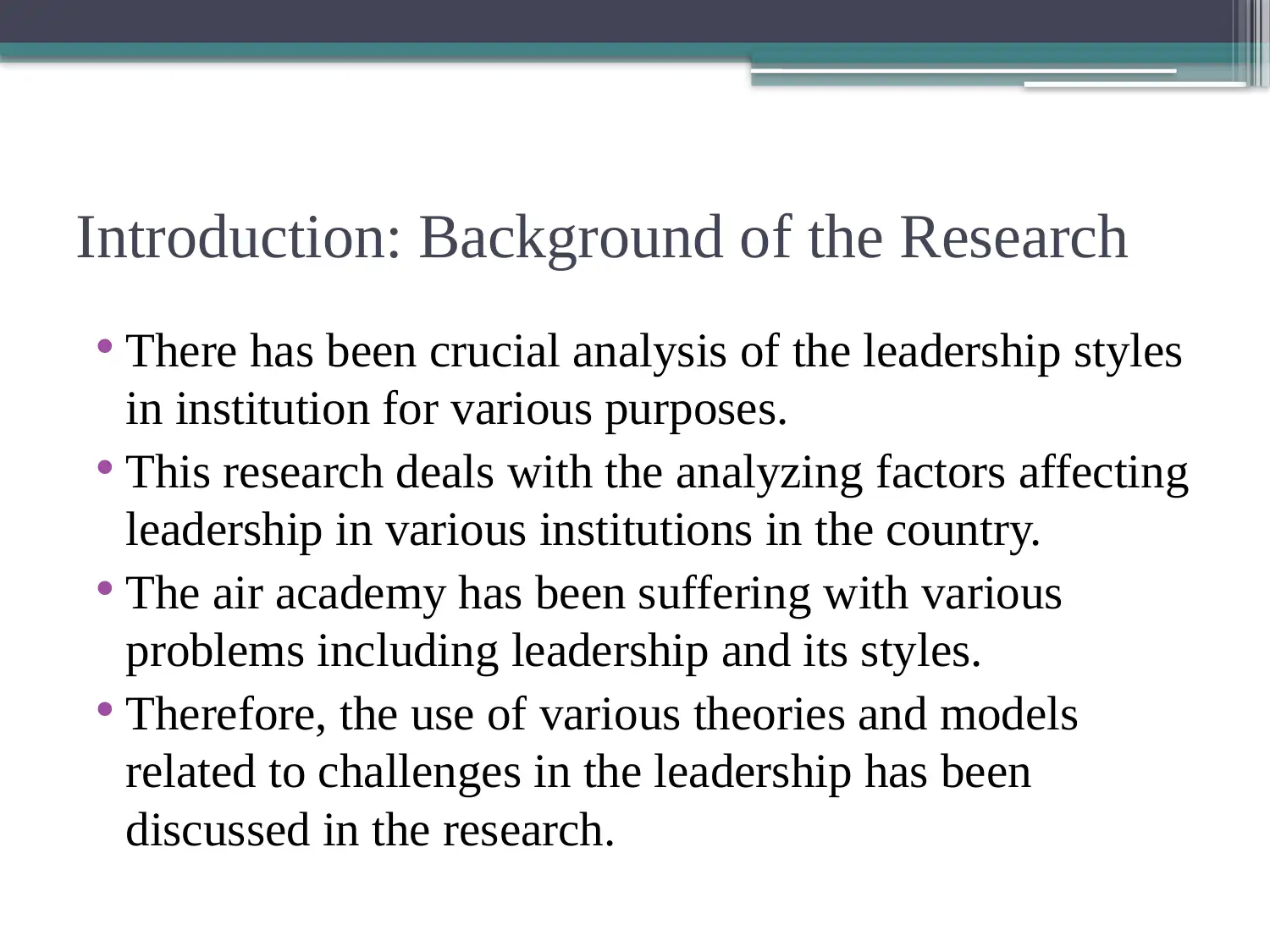
Introduction: Background of the Research
• There has been crucial analysis of the leadership styles
in institution for various purposes.
• This research deals with the analyzing factors affecting
leadership in various institutions in the country.
• The air academy has been suffering with various
problems including leadership and its styles.
• Therefore, the use of various theories and models
related to challenges in the leadership has been
discussed in the research.
• There has been crucial analysis of the leadership styles
in institution for various purposes.
• This research deals with the analyzing factors affecting
leadership in various institutions in the country.
• The air academy has been suffering with various
problems including leadership and its styles.
• Therefore, the use of various theories and models
related to challenges in the leadership has been
discussed in the research.
Secure Best Marks with AI Grader
Need help grading? Try our AI Grader for instant feedback on your assignments.
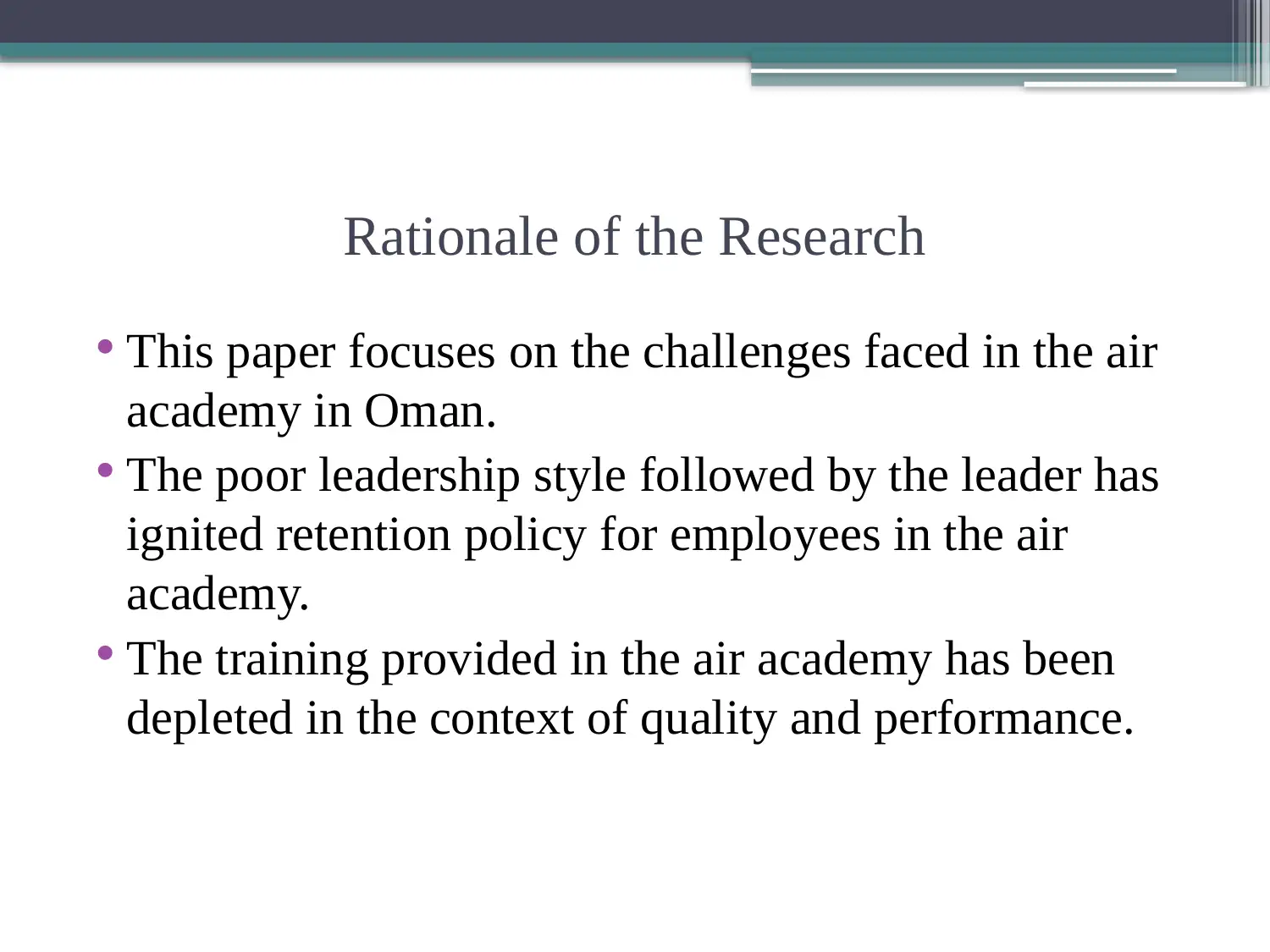
Rationale of the Research
• This paper focuses on the challenges faced in the air
academy in Oman.
• The poor leadership style followed by the leader has
ignited retention policy for employees in the air
academy.
• The training provided in the air academy has been
depleted in the context of quality and performance.
• This paper focuses on the challenges faced in the air
academy in Oman.
• The poor leadership style followed by the leader has
ignited retention policy for employees in the air
academy.
• The training provided in the air academy has been
depleted in the context of quality and performance.
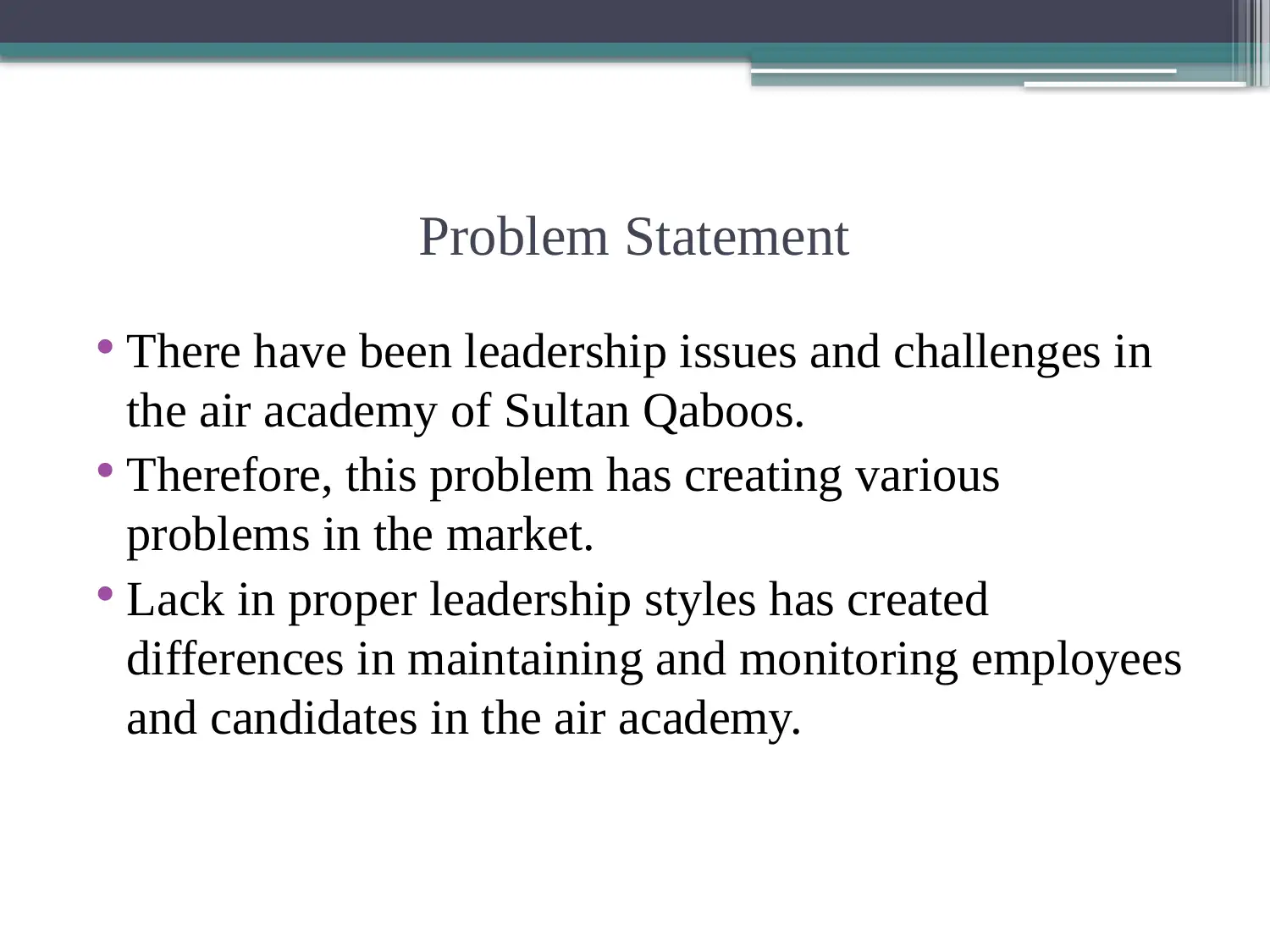
Problem Statement
• There have been leadership issues and challenges in
the air academy of Sultan Qaboos.
• Therefore, this problem has creating various
problems in the market.
• Lack in proper leadership styles has created
differences in maintaining and monitoring employees
and candidates in the air academy.
• There have been leadership issues and challenges in
the air academy of Sultan Qaboos.
• Therefore, this problem has creating various
problems in the market.
• Lack in proper leadership styles has created
differences in maintaining and monitoring employees
and candidates in the air academy.
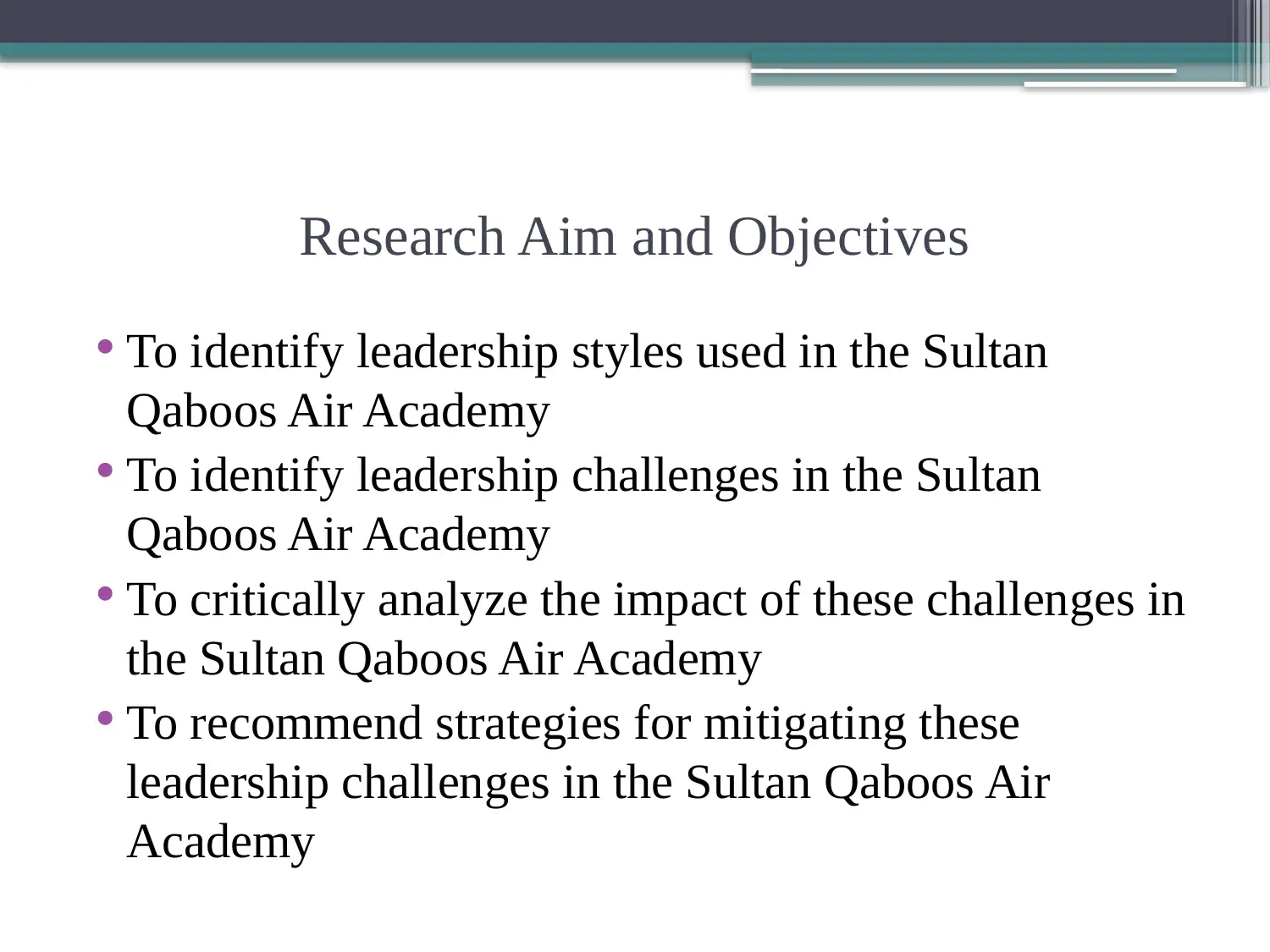
Research Aim and Objectives
• To identify leadership styles used in the Sultan
Qaboos Air Academy
• To identify leadership challenges in the Sultan
Qaboos Air Academy
• To critically analyze the impact of these challenges in
the Sultan Qaboos Air Academy
• To recommend strategies for mitigating these
leadership challenges in the Sultan Qaboos Air
Academy
• To identify leadership styles used in the Sultan
Qaboos Air Academy
• To identify leadership challenges in the Sultan
Qaboos Air Academy
• To critically analyze the impact of these challenges in
the Sultan Qaboos Air Academy
• To recommend strategies for mitigating these
leadership challenges in the Sultan Qaboos Air
Academy
Paraphrase This Document
Need a fresh take? Get an instant paraphrase of this document with our AI Paraphraser
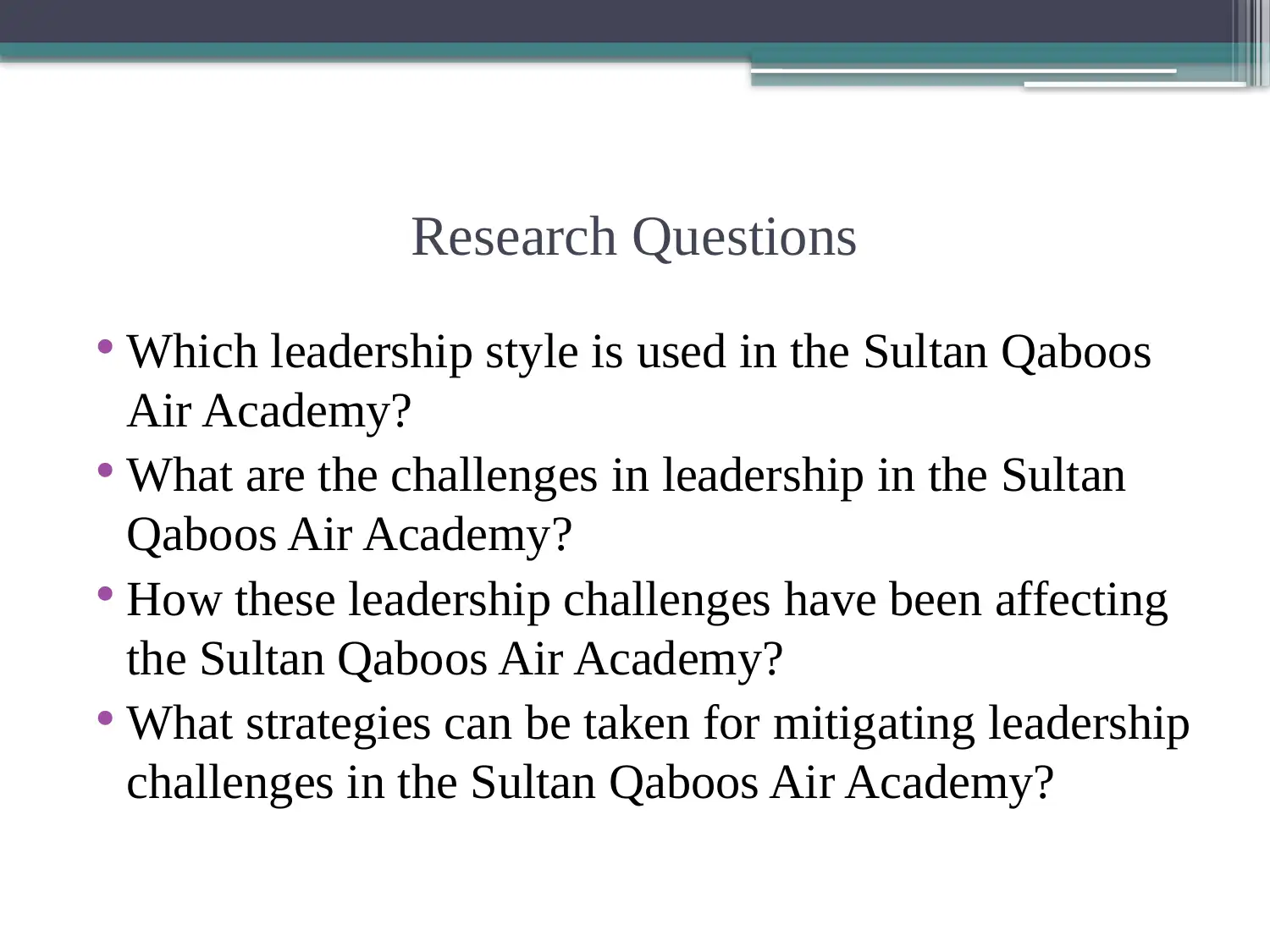
Research Questions
• Which leadership style is used in the Sultan Qaboos
Air Academy?
• What are the challenges in leadership in the Sultan
Qaboos Air Academy?
• How these leadership challenges have been affecting
the Sultan Qaboos Air Academy?
• What strategies can be taken for mitigating leadership
challenges in the Sultan Qaboos Air Academy?
• Which leadership style is used in the Sultan Qaboos
Air Academy?
• What are the challenges in leadership in the Sultan
Qaboos Air Academy?
• How these leadership challenges have been affecting
the Sultan Qaboos Air Academy?
• What strategies can be taken for mitigating leadership
challenges in the Sultan Qaboos Air Academy?

Research Structure
• The first chapter describes about the basic introduction
about research topic.
• The second chapter focuses on the literature review of
the variables included in the research topic.
• The third chapter deals with methodology followed by
the research.
• The fourth chapter deals with the data findings and
analysis.
• Final chapter concludes all the finding and analysis of
the whole research.
• The first chapter describes about the basic introduction
about research topic.
• The second chapter focuses on the literature review of
the variables included in the research topic.
• The third chapter deals with methodology followed by
the research.
• The fourth chapter deals with the data findings and
analysis.
• Final chapter concludes all the finding and analysis of
the whole research.
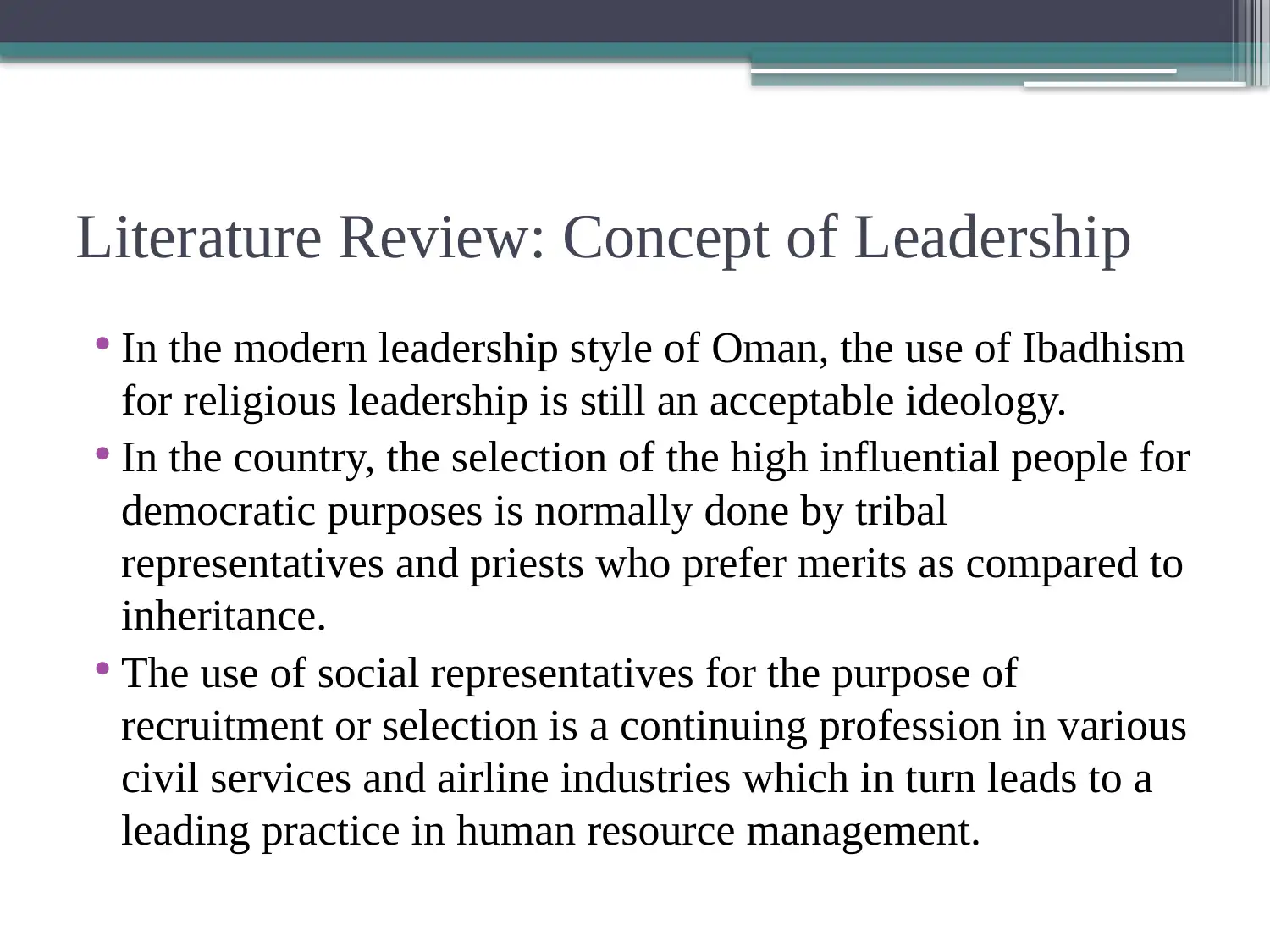
Literature Review: Concept of Leadership
• In the modern leadership style of Oman, the use of Ibadhism
for religious leadership is still an acceptable ideology.
• In the country, the selection of the high influential people for
democratic purposes is normally done by tribal
representatives and priests who prefer merits as compared to
inheritance.
• The use of social representatives for the purpose of
recruitment or selection is a continuing profession in various
civil services and airline industries which in turn leads to a
leading practice in human resource management.
• In the modern leadership style of Oman, the use of Ibadhism
for religious leadership is still an acceptable ideology.
• In the country, the selection of the high influential people for
democratic purposes is normally done by tribal
representatives and priests who prefer merits as compared to
inheritance.
• The use of social representatives for the purpose of
recruitment or selection is a continuing profession in various
civil services and airline industries which in turn leads to a
leading practice in human resource management.
Secure Best Marks with AI Grader
Need help grading? Try our AI Grader for instant feedback on your assignments.
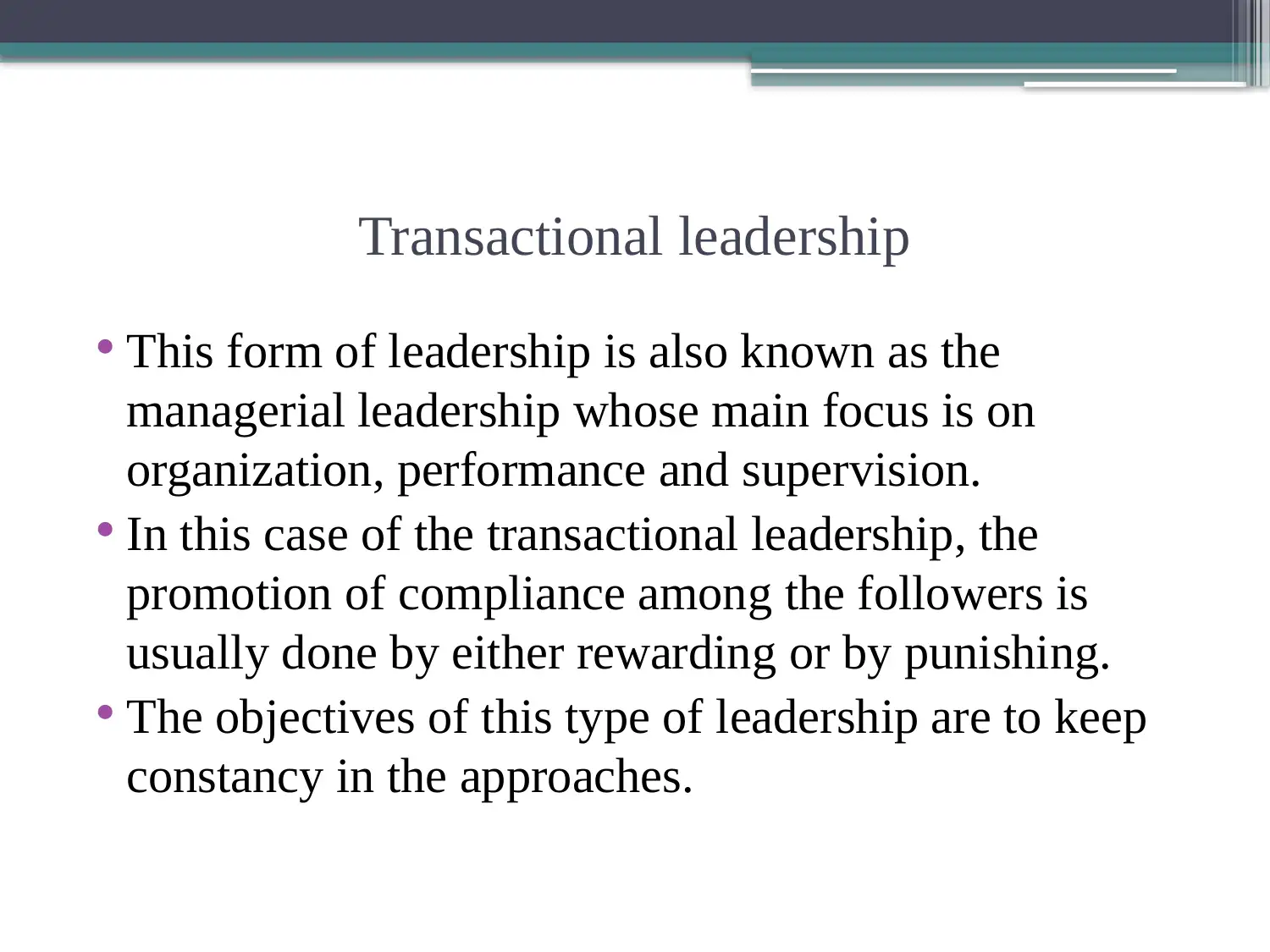
Transactional leadership
• This form of leadership is also known as the
managerial leadership whose main focus is on
organization, performance and supervision.
• In this case of the transactional leadership, the
promotion of compliance among the followers is
usually done by either rewarding or by punishing.
• The objectives of this type of leadership are to keep
constancy in the approaches.
• This form of leadership is also known as the
managerial leadership whose main focus is on
organization, performance and supervision.
• In this case of the transactional leadership, the
promotion of compliance among the followers is
usually done by either rewarding or by punishing.
• The objectives of this type of leadership are to keep
constancy in the approaches.
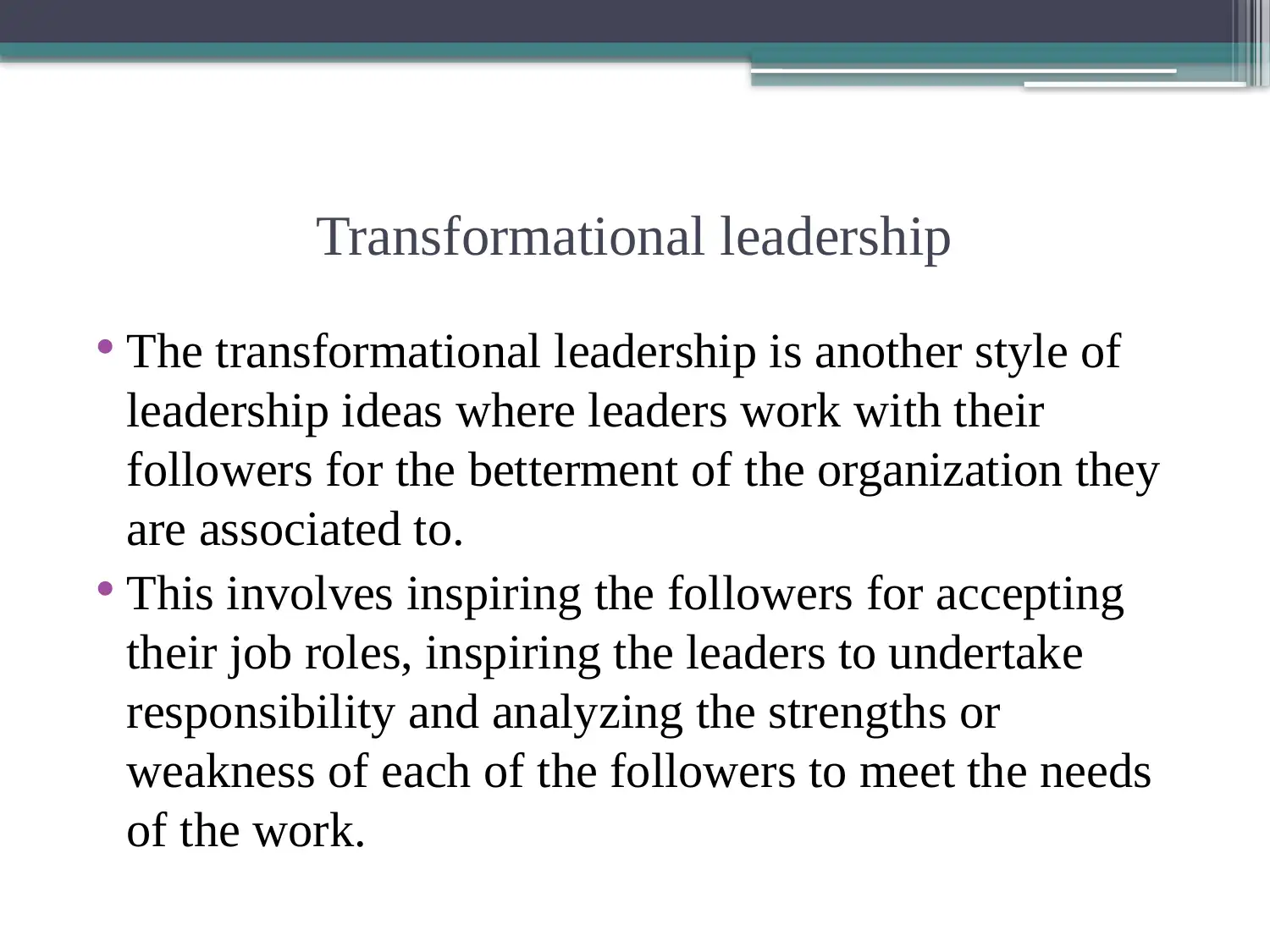
Transformational leadership
• The transformational leadership is another style of
leadership ideas where leaders work with their
followers for the betterment of the organization they
are associated to.
• This involves inspiring the followers for accepting
their job roles, inspiring the leaders to undertake
responsibility and analyzing the strengths or
weakness of each of the followers to meet the needs
of the work.
• The transformational leadership is another style of
leadership ideas where leaders work with their
followers for the betterment of the organization they
are associated to.
• This involves inspiring the followers for accepting
their job roles, inspiring the leaders to undertake
responsibility and analyzing the strengths or
weakness of each of the followers to meet the needs
of the work.
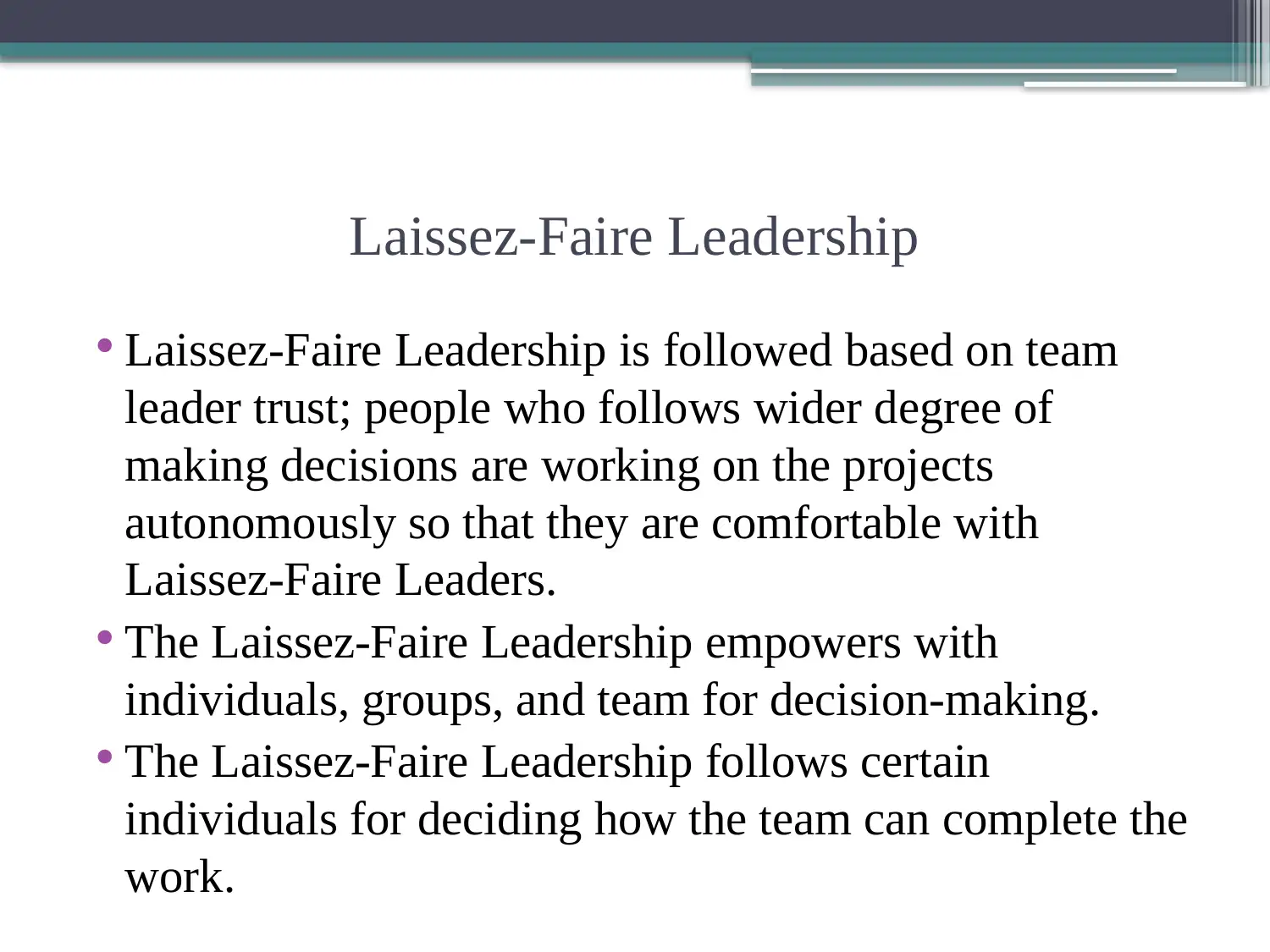
Laissez-Faire Leadership
• Laissez-Faire Leadership is followed based on team
leader trust; people who follows wider degree of
making decisions are working on the projects
autonomously so that they are comfortable with
Laissez-Faire Leaders.
• The Laissez-Faire Leadership empowers with
individuals, groups, and team for decision-making.
• The Laissez-Faire Leadership follows certain
individuals for deciding how the team can complete the
work.
• Laissez-Faire Leadership is followed based on team
leader trust; people who follows wider degree of
making decisions are working on the projects
autonomously so that they are comfortable with
Laissez-Faire Leaders.
• The Laissez-Faire Leadership empowers with
individuals, groups, and team for decision-making.
• The Laissez-Faire Leadership follows certain
individuals for deciding how the team can complete the
work.
Paraphrase This Document
Need a fresh take? Get an instant paraphrase of this document with our AI Paraphraser
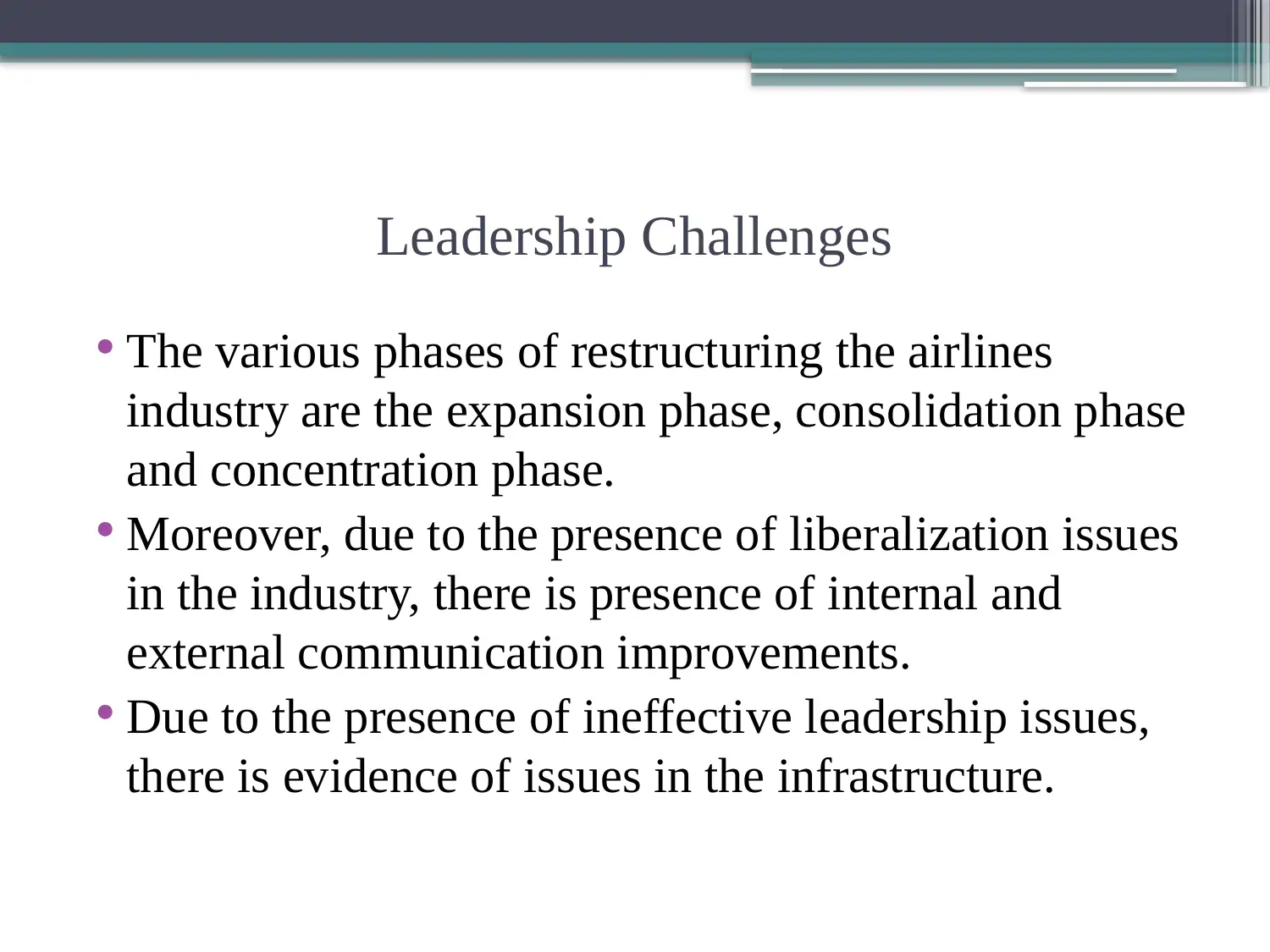
Leadership Challenges
• The various phases of restructuring the airlines
industry are the expansion phase, consolidation phase
and concentration phase.
• Moreover, due to the presence of liberalization issues
in the industry, there is presence of internal and
external communication improvements.
• Due to the presence of ineffective leadership issues,
there is evidence of issues in the infrastructure.
• The various phases of restructuring the airlines
industry are the expansion phase, consolidation phase
and concentration phase.
• Moreover, due to the presence of liberalization issues
in the industry, there is presence of internal and
external communication improvements.
• Due to the presence of ineffective leadership issues,
there is evidence of issues in the infrastructure.
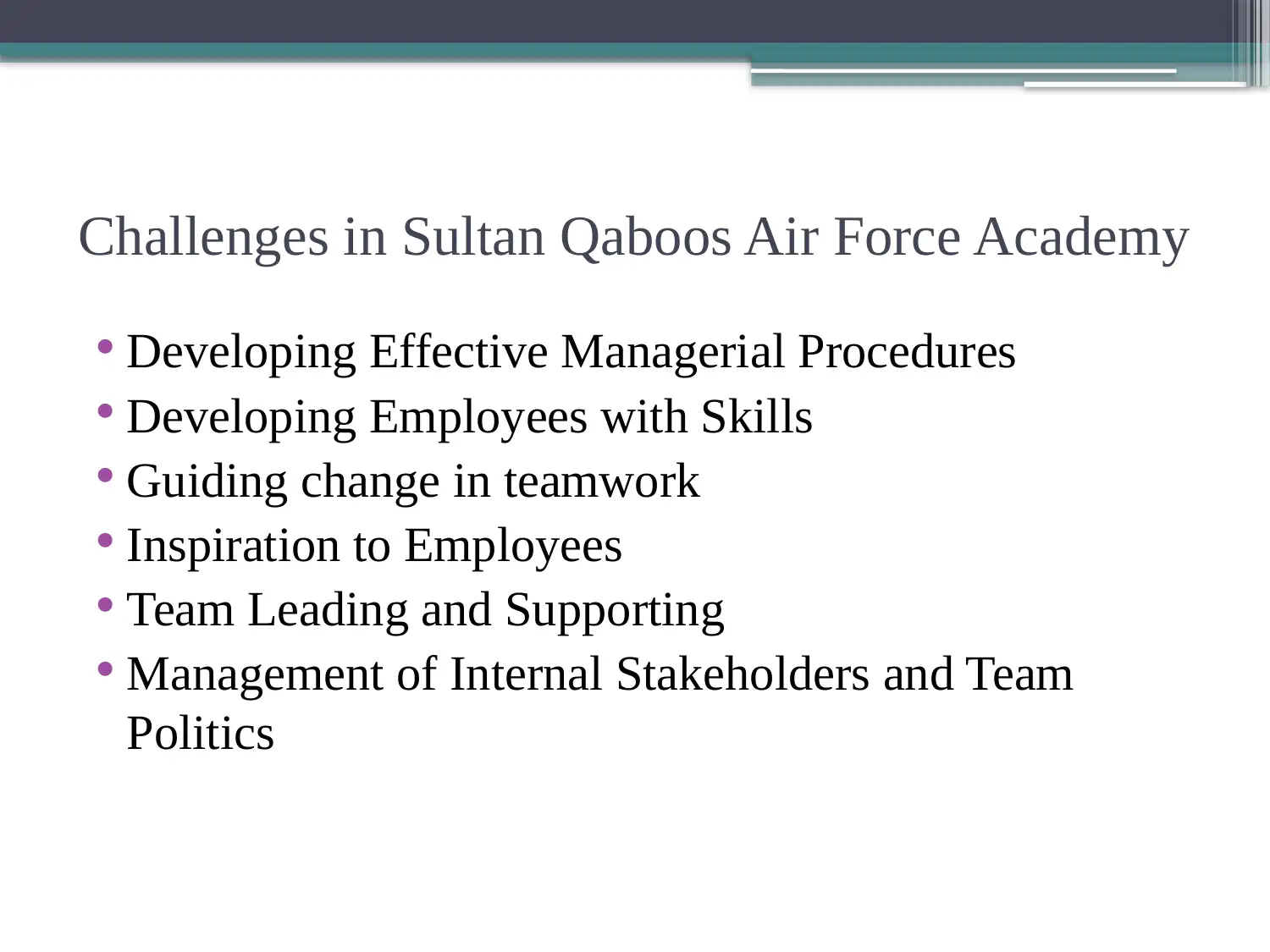
Challenges in Sultan Qaboos Air Force Academy
• Developing Effective Managerial Procedures
• Developing Employees with Skills
• Guiding change in teamwork
• Inspiration to Employees
• Team Leading and Supporting
• Management of Internal Stakeholders and Team
Politics
• Developing Effective Managerial Procedures
• Developing Employees with Skills
• Guiding change in teamwork
• Inspiration to Employees
• Team Leading and Supporting
• Management of Internal Stakeholders and Team
Politics
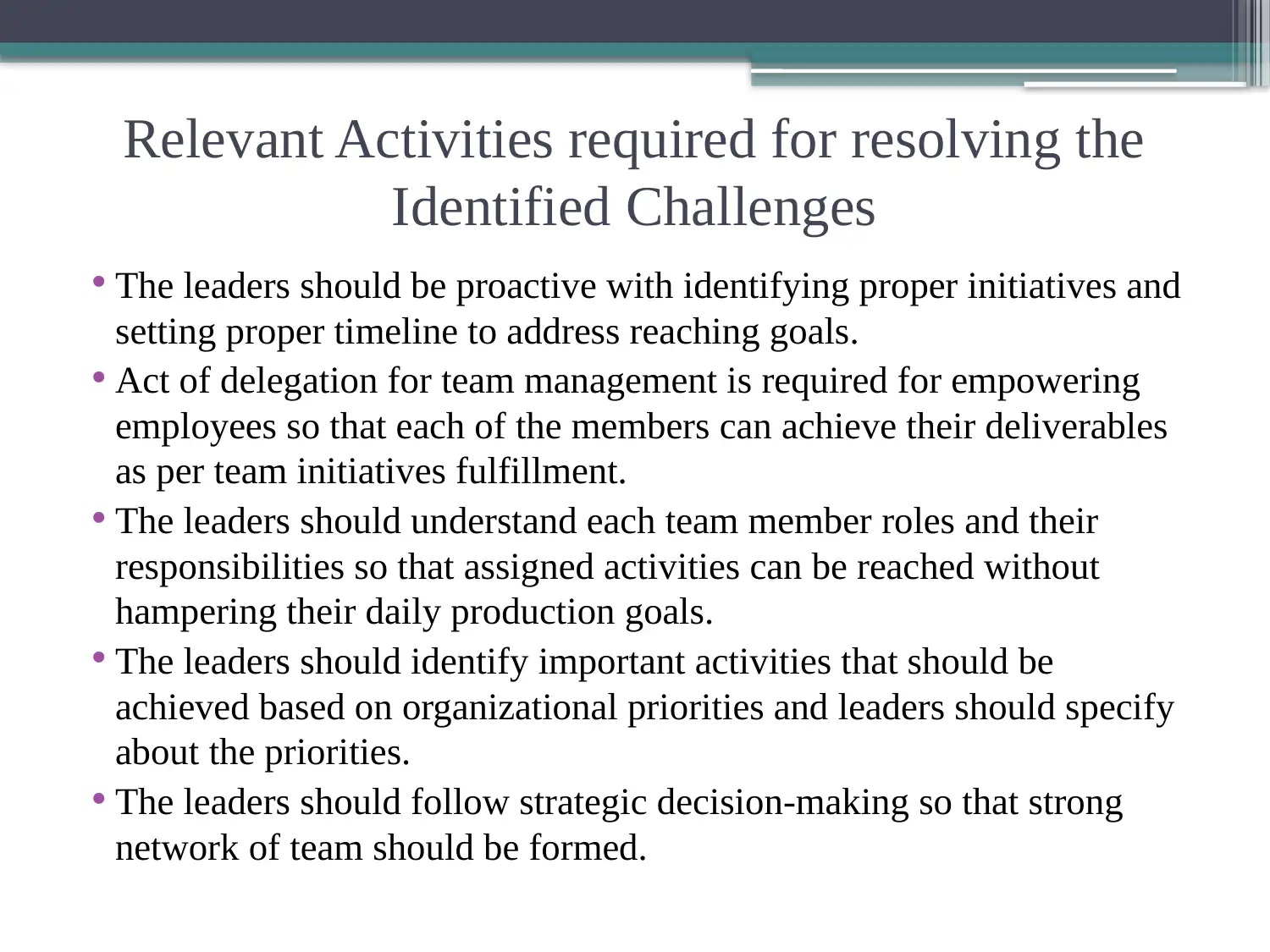
Relevant Activities required for resolving the
Identified Challenges
• The leaders should be proactive with identifying proper initiatives and
setting proper timeline to address reaching goals.
• Act of delegation for team management is required for empowering
employees so that each of the members can achieve their deliverables
as per team initiatives fulfillment.
• The leaders should understand each team member roles and their
responsibilities so that assigned activities can be reached without
hampering their daily production goals.
• The leaders should identify important activities that should be
achieved based on organizational priorities and leaders should specify
about the priorities.
• The leaders should follow strategic decision-making so that strong
network of team should be formed.
Identified Challenges
• The leaders should be proactive with identifying proper initiatives and
setting proper timeline to address reaching goals.
• Act of delegation for team management is required for empowering
employees so that each of the members can achieve their deliverables
as per team initiatives fulfillment.
• The leaders should understand each team member roles and their
responsibilities so that assigned activities can be reached without
hampering their daily production goals.
• The leaders should identify important activities that should be
achieved based on organizational priorities and leaders should specify
about the priorities.
• The leaders should follow strategic decision-making so that strong
network of team should be formed.
Secure Best Marks with AI Grader
Need help grading? Try our AI Grader for instant feedback on your assignments.
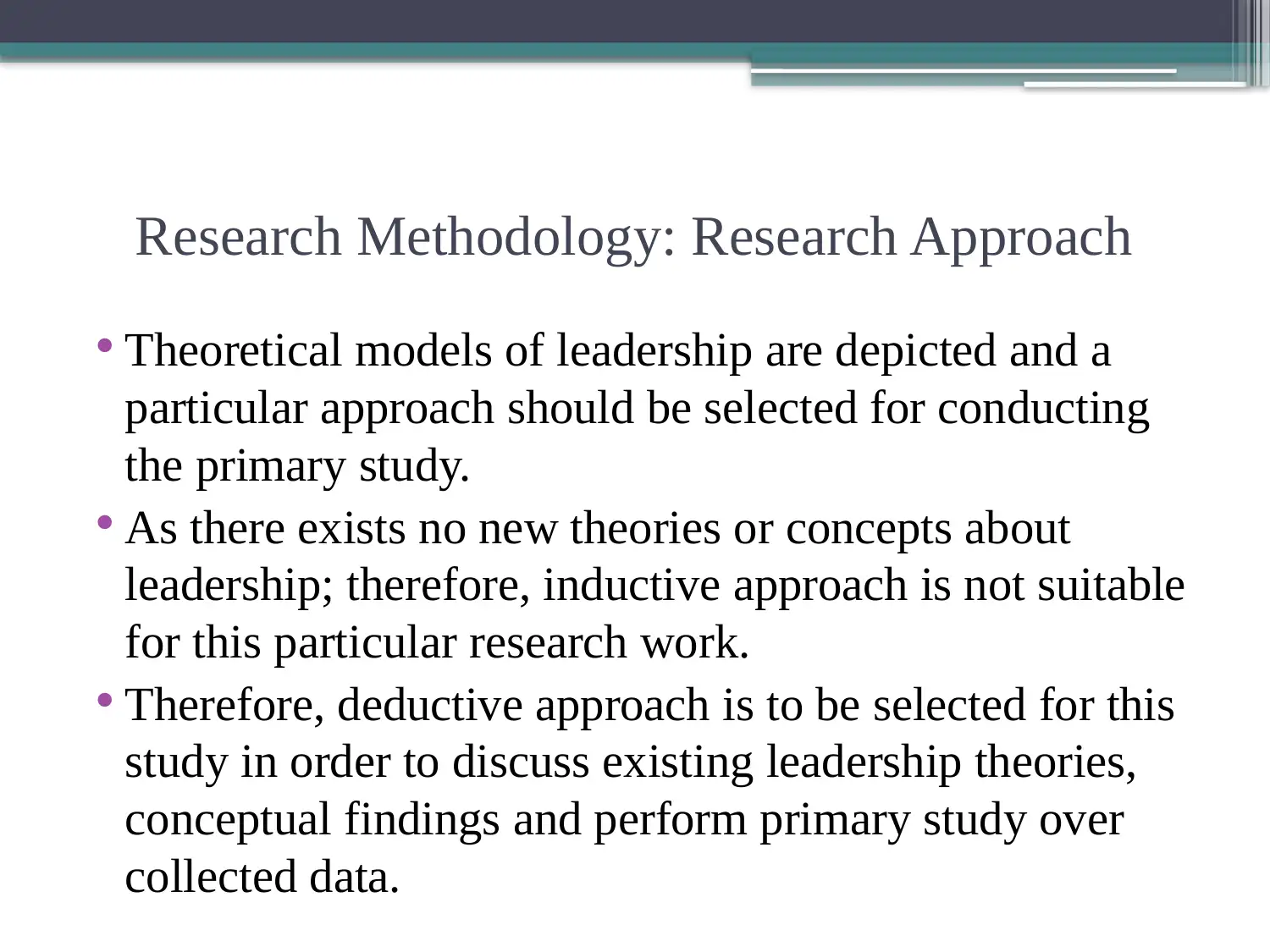
Research Methodology: Research Approach
• Theoretical models of leadership are depicted and a
particular approach should be selected for conducting
the primary study.
• As there exists no new theories or concepts about
leadership; therefore, inductive approach is not suitable
for this particular research work.
• Therefore, deductive approach is to be selected for this
study in order to discuss existing leadership theories,
conceptual findings and perform primary study over
collected data.
• Theoretical models of leadership are depicted and a
particular approach should be selected for conducting
the primary study.
• As there exists no new theories or concepts about
leadership; therefore, inductive approach is not suitable
for this particular research work.
• Therefore, deductive approach is to be selected for this
study in order to discuss existing leadership theories,
conceptual findings and perform primary study over
collected data.
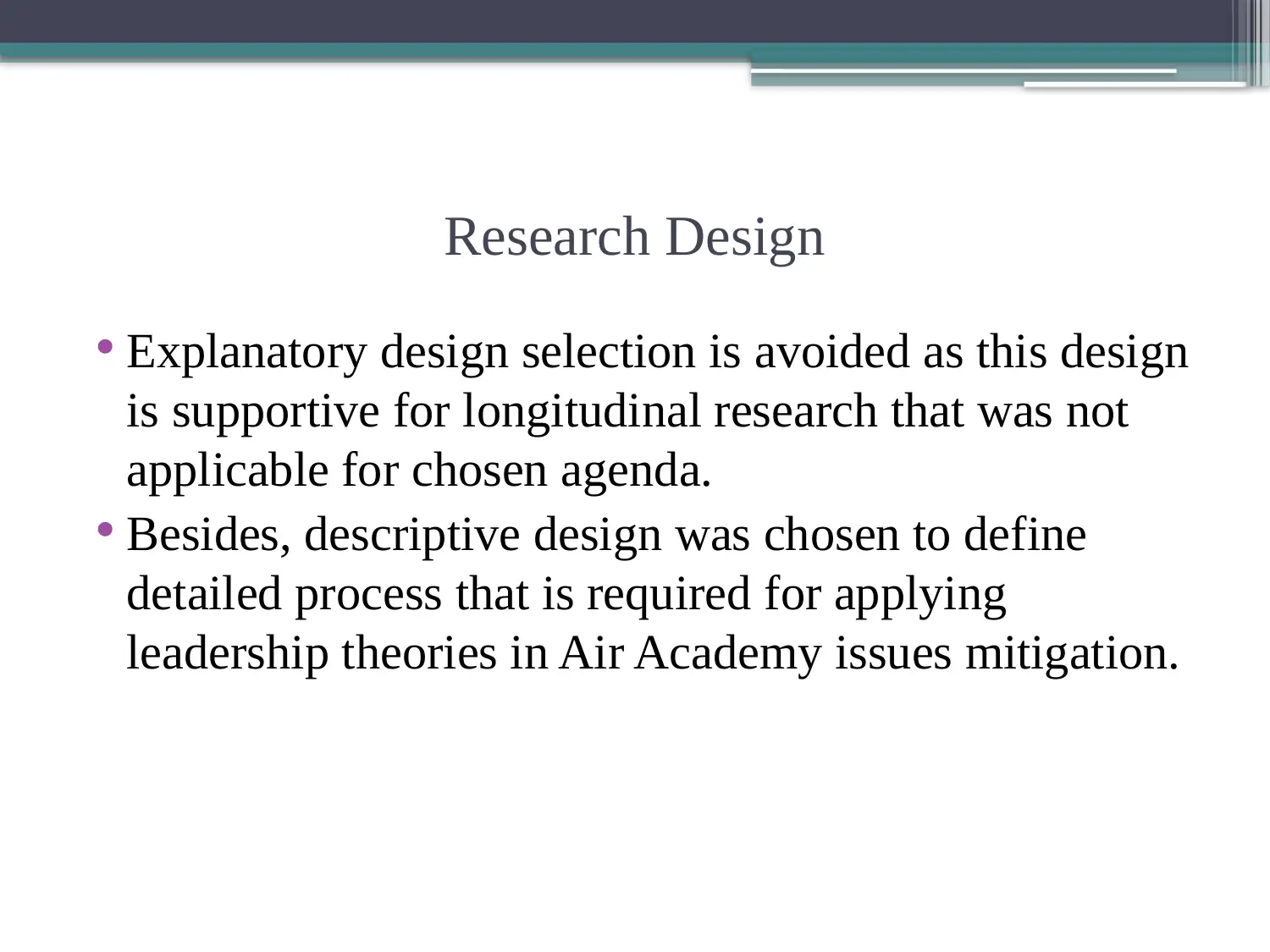
Research Design
• Explanatory design selection is avoided as this design
is supportive for longitudinal research that was not
applicable for chosen agenda.
• Besides, descriptive design was chosen to define
detailed process that is required for applying
leadership theories in Air Academy issues mitigation.
• Explanatory design selection is avoided as this design
is supportive for longitudinal research that was not
applicable for chosen agenda.
• Besides, descriptive design was chosen to define
detailed process that is required for applying
leadership theories in Air Academy issues mitigation.
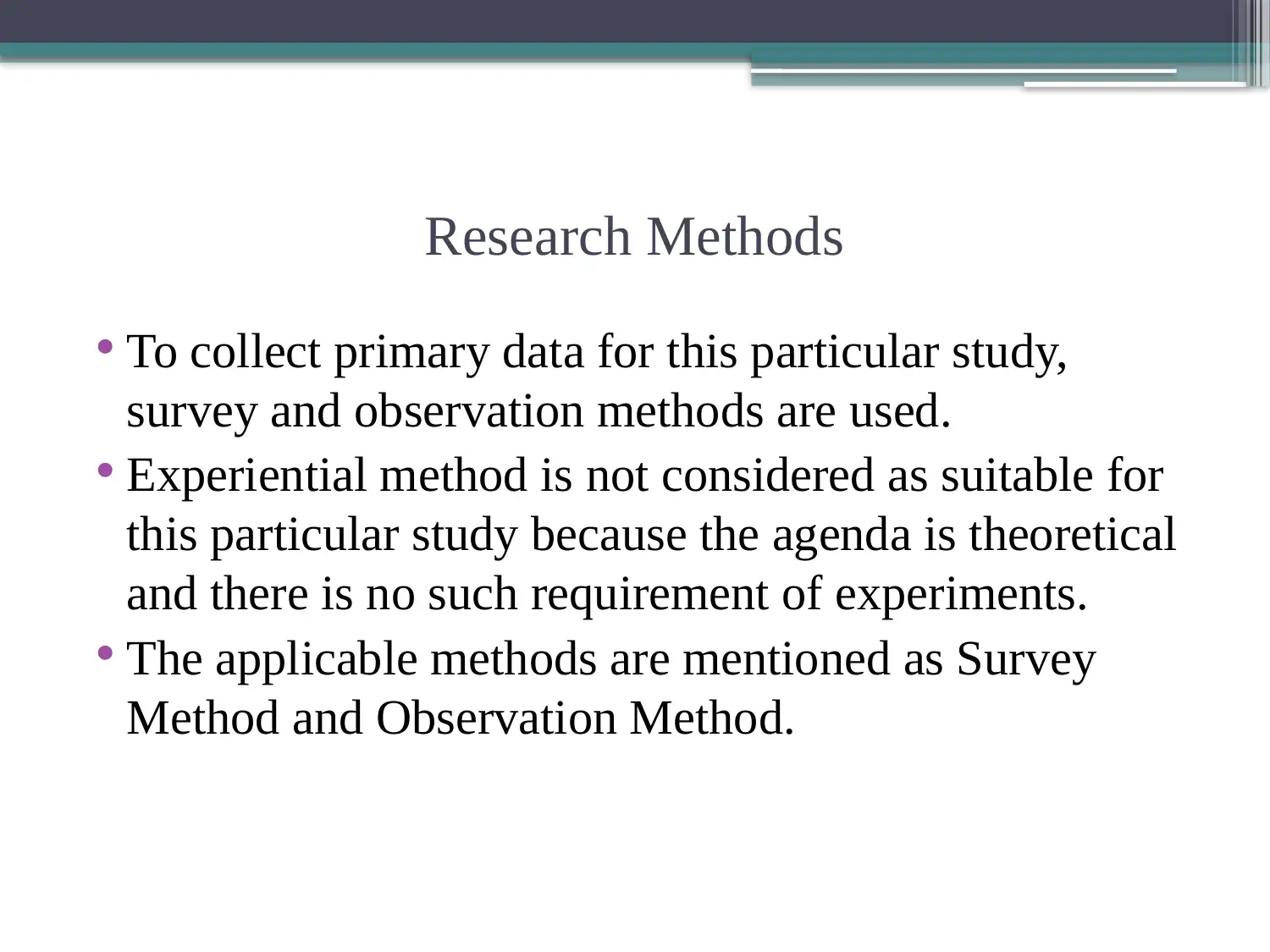
Research Methods
• To collect primary data for this particular study,
survey and observation methods are used.
• Experiential method is not considered as suitable for
this particular study because the agenda is theoretical
and there is no such requirement of experiments.
• The applicable methods are mentioned as Survey
Method and Observation Method.
• To collect primary data for this particular study,
survey and observation methods are used.
• Experiential method is not considered as suitable for
this particular study because the agenda is theoretical
and there is no such requirement of experiments.
• The applicable methods are mentioned as Survey
Method and Observation Method.
Paraphrase This Document
Need a fresh take? Get an instant paraphrase of this document with our AI Paraphraser
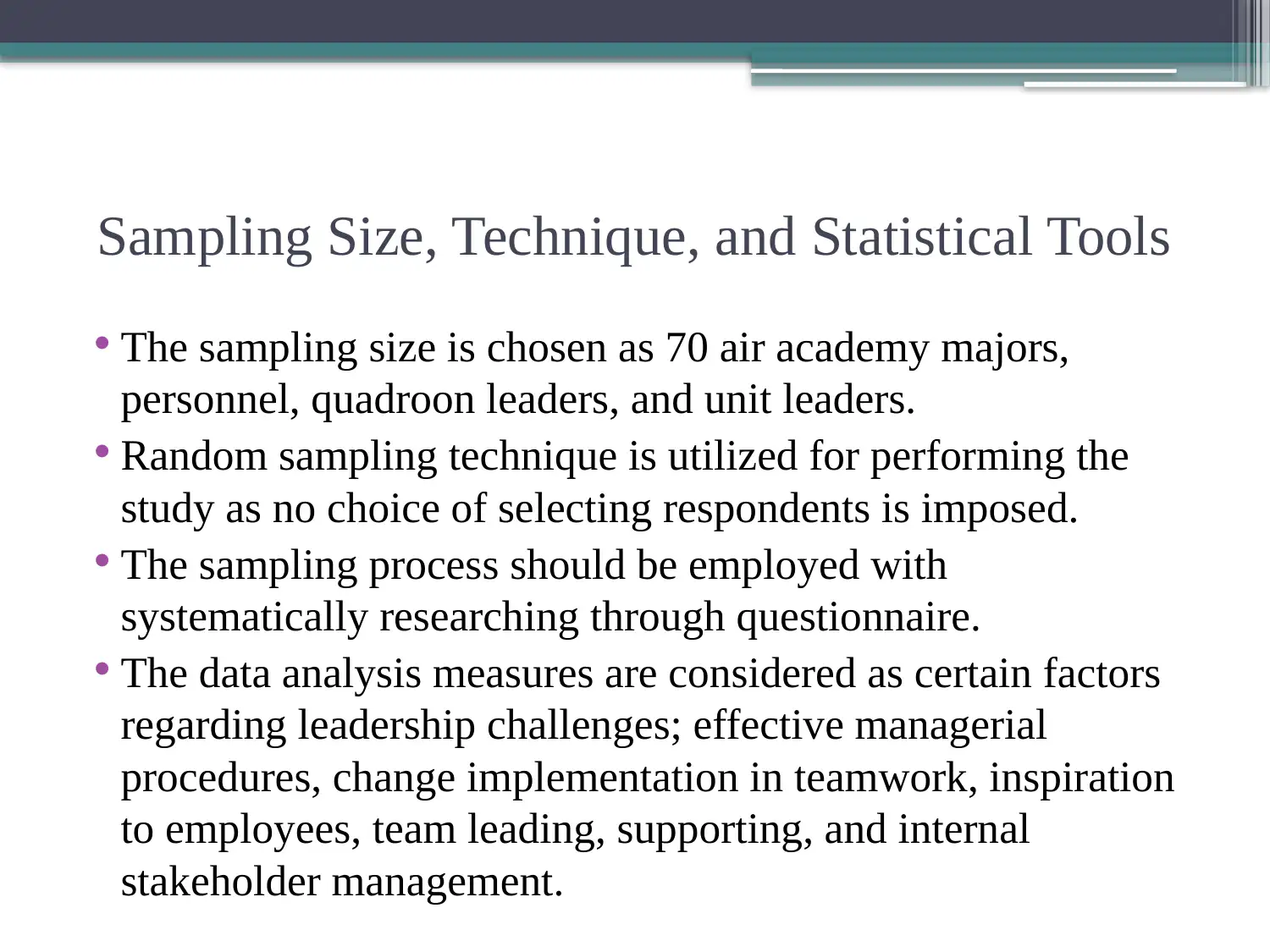
Sampling Size, Technique, and Statistical Tools
• The sampling size is chosen as 70 air academy majors,
personnel, quadroon leaders, and unit leaders.
• Random sampling technique is utilized for performing the
study as no choice of selecting respondents is imposed.
• The sampling process should be employed with
systematically researching through questionnaire.
• The data analysis measures are considered as certain factors
regarding leadership challenges; effective managerial
procedures, change implementation in teamwork, inspiration
to employees, team leading, supporting, and internal
stakeholder management.
• The sampling size is chosen as 70 air academy majors,
personnel, quadroon leaders, and unit leaders.
• Random sampling technique is utilized for performing the
study as no choice of selecting respondents is imposed.
• The sampling process should be employed with
systematically researching through questionnaire.
• The data analysis measures are considered as certain factors
regarding leadership challenges; effective managerial
procedures, change implementation in teamwork, inspiration
to employees, team leading, supporting, and internal
stakeholder management.
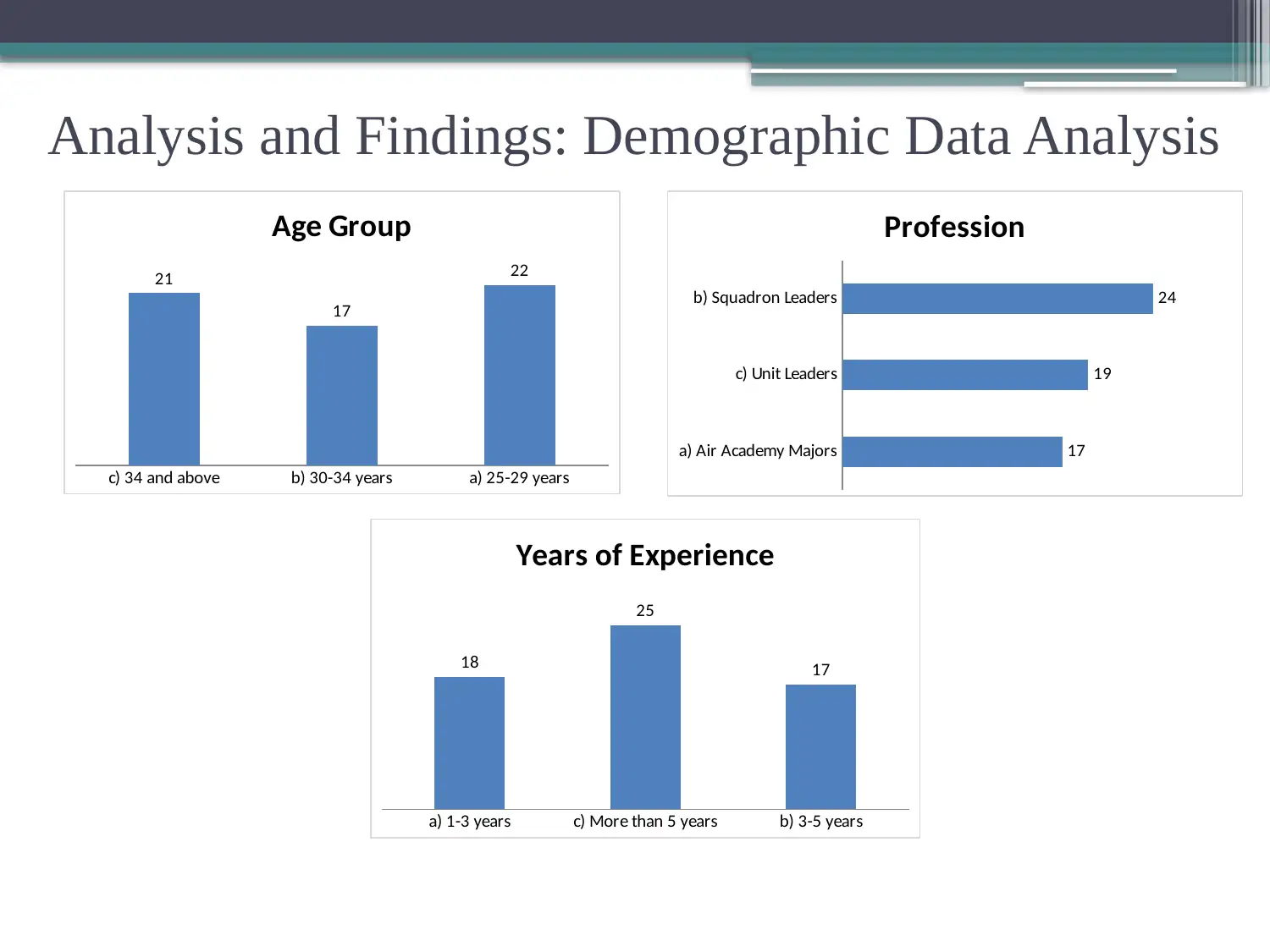
Analysis and Findings: Demographic Data Analysis
c) 34 and above b) 30-34 years a) 25-29 years
21
17
22
Age Group
a) Air Academy Majors
c) Unit Leaders
b) Squadron Leaders
17
19
24
Profession
a) 1-3 years c) More than 5 years b) 3-5 years
18
25
17
Years of Experience
c) 34 and above b) 30-34 years a) 25-29 years
21
17
22
Age Group
a) Air Academy Majors
c) Unit Leaders
b) Squadron Leaders
17
19
24
Profession
a) 1-3 years c) More than 5 years b) 3-5 years
18
25
17
Years of Experience
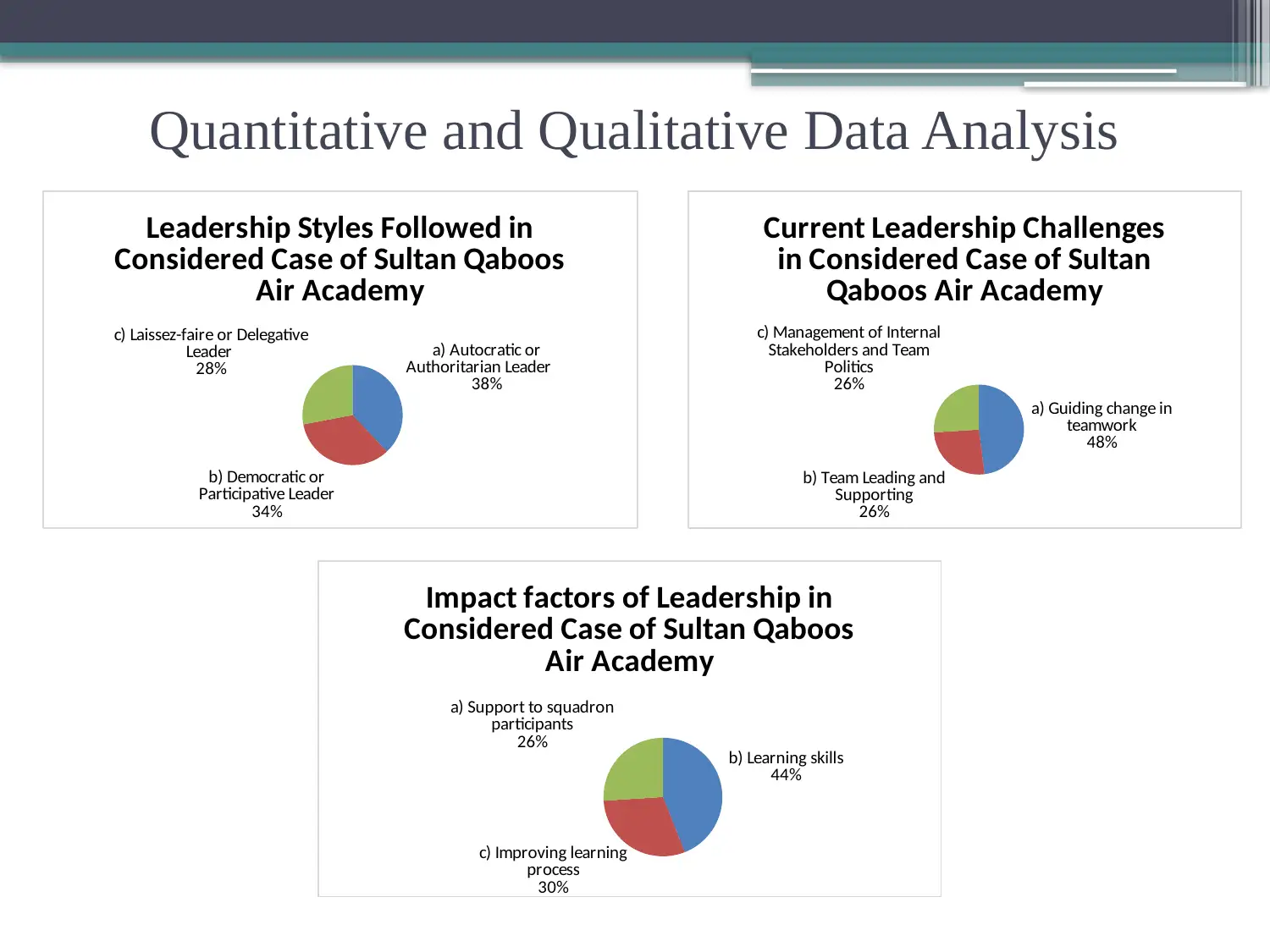
Quantitative and Qualitative Data Analysis
a) Autocratic or
Authoritarian Leader
38%
b) Democratic or
Participative Leader
34%
c) Laissez-faire or Delegative
Leader
28%
Leadership Styles Followed in
Considered Case of Sultan Qaboos
Air Academy
a) Guiding change in
teamwork
48%
b) Team Leading and
Supporting
26%
c) Management of Internal
Stakeholders and Team
Politics
26%
Current Leadership Challenges
in Considered Case of Sultan
Qaboos Air Academy
b) Learning skills
44%
c) Improving learning
process
30%
a) Support to squadron
participants
26%
Impact factors of Leadership in
Considered Case of Sultan Qaboos
Air Academy
a) Autocratic or
Authoritarian Leader
38%
b) Democratic or
Participative Leader
34%
c) Laissez-faire or Delegative
Leader
28%
Leadership Styles Followed in
Considered Case of Sultan Qaboos
Air Academy
a) Guiding change in
teamwork
48%
b) Team Leading and
Supporting
26%
c) Management of Internal
Stakeholders and Team
Politics
26%
Current Leadership Challenges
in Considered Case of Sultan
Qaboos Air Academy
b) Learning skills
44%
c) Improving learning
process
30%
a) Support to squadron
participants
26%
Impact factors of Leadership in
Considered Case of Sultan Qaboos
Air Academy
Secure Best Marks with AI Grader
Need help grading? Try our AI Grader for instant feedback on your assignments.
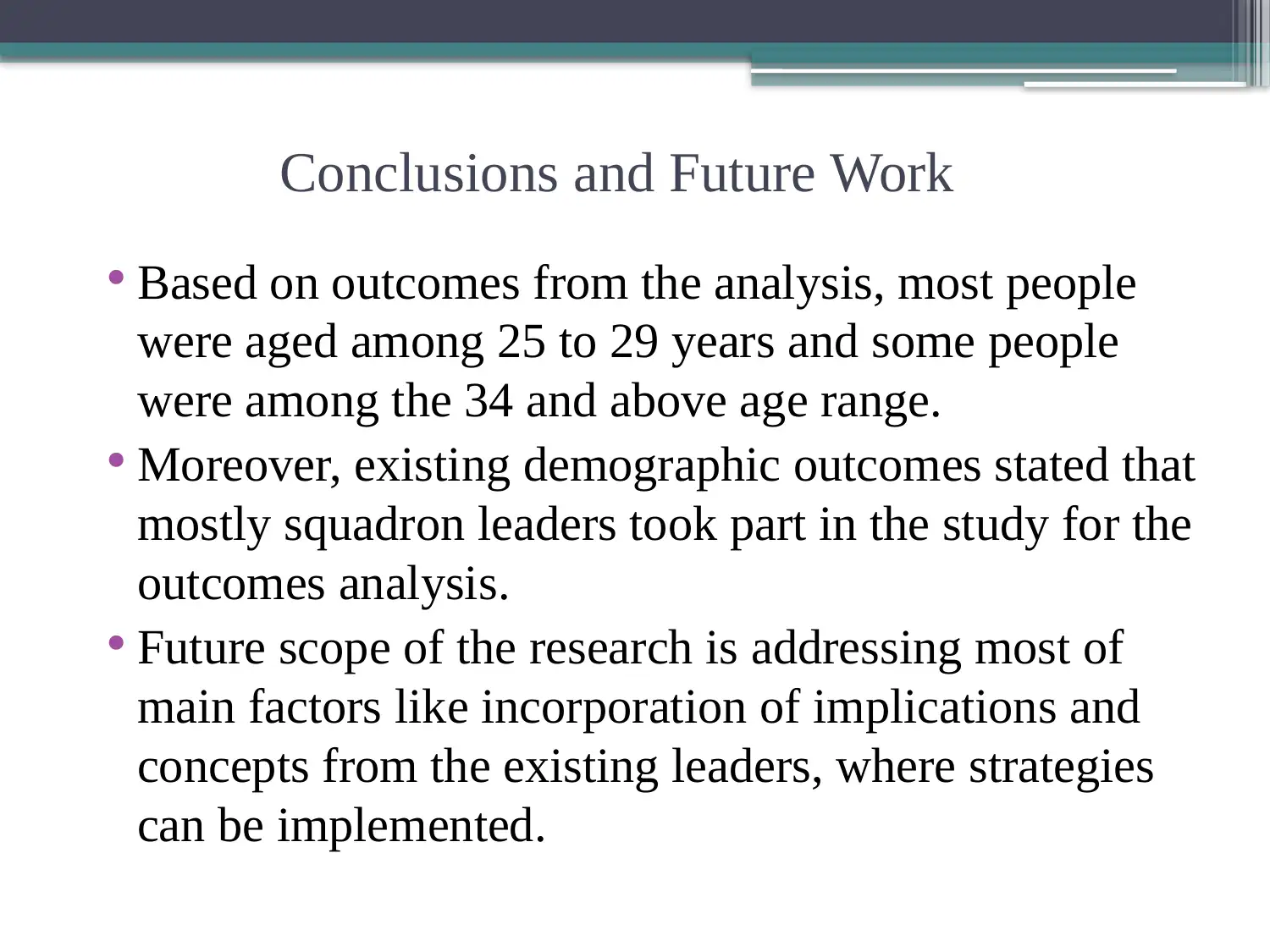
Conclusions and Future Work
• Based on outcomes from the analysis, most people
were aged among 25 to 29 years and some people
were among the 34 and above age range.
• Moreover, existing demographic outcomes stated that
mostly squadron leaders took part in the study for the
outcomes analysis.
• Future scope of the research is addressing most of
main factors like incorporation of implications and
concepts from the existing leaders, where strategies
can be implemented.
• Based on outcomes from the analysis, most people
were aged among 25 to 29 years and some people
were among the 34 and above age range.
• Moreover, existing demographic outcomes stated that
mostly squadron leaders took part in the study for the
outcomes analysis.
• Future scope of the research is addressing most of
main factors like incorporation of implications and
concepts from the existing leaders, where strategies
can be implemented.
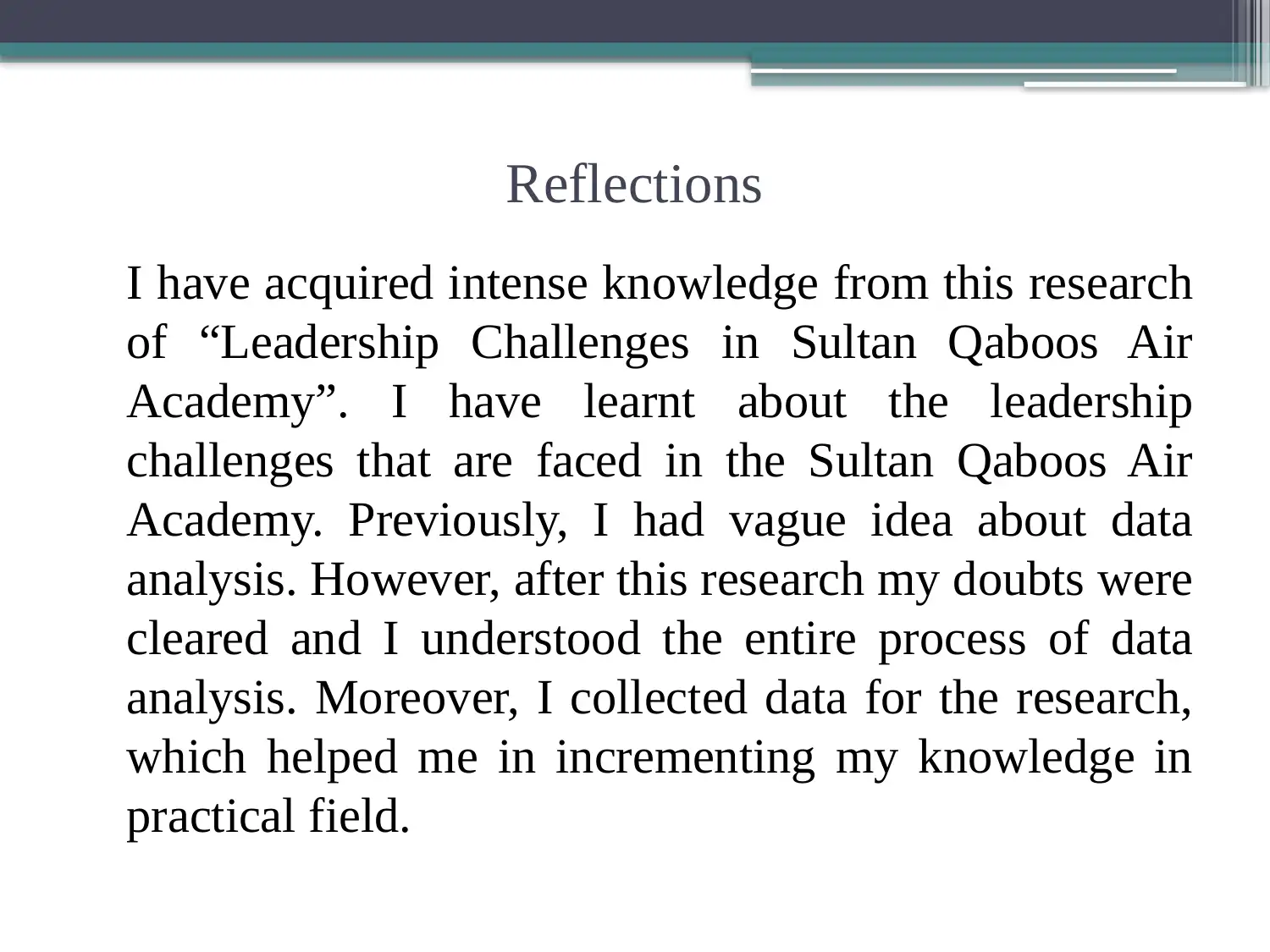
Reflections
I have acquired intense knowledge from this research
of “Leadership Challenges in Sultan Qaboos Air
Academy”. I have learnt about the leadership
challenges that are faced in the Sultan Qaboos Air
Academy. Previously, I had vague idea about data
analysis. However, after this research my doubts were
cleared and I understood the entire process of data
analysis. Moreover, I collected data for the research,
which helped me in incrementing my knowledge in
practical field.
I have acquired intense knowledge from this research
of “Leadership Challenges in Sultan Qaboos Air
Academy”. I have learnt about the leadership
challenges that are faced in the Sultan Qaboos Air
Academy. Previously, I had vague idea about data
analysis. However, after this research my doubts were
cleared and I understood the entire process of data
analysis. Moreover, I collected data for the research,
which helped me in incrementing my knowledge in
practical field.
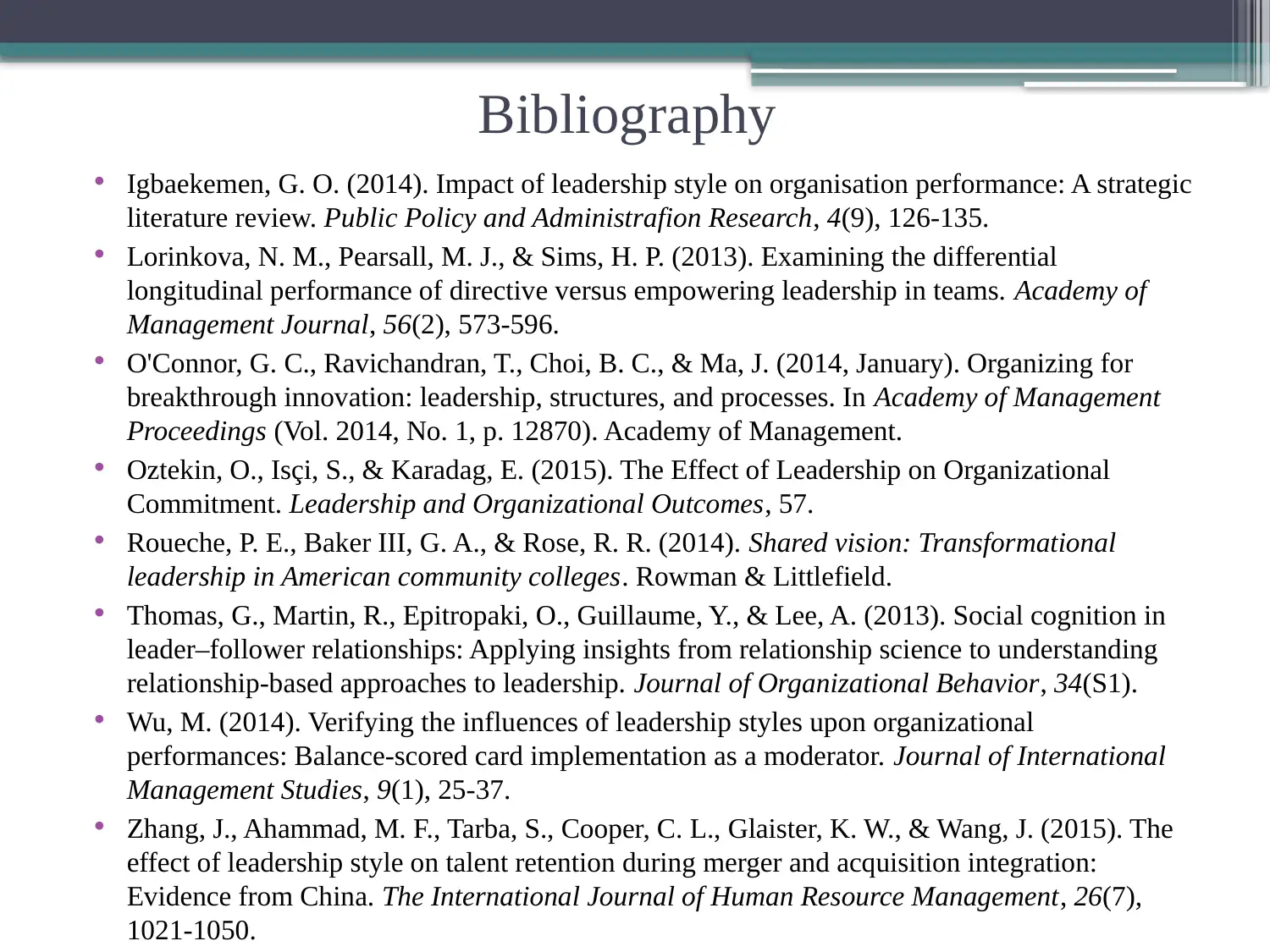
Bibliography
• Igbaekemen, G. O. (2014). Impact of leadership style on organisation performance: A strategic
literature review. Public Policy and Administrafion Research, 4(9), 126-135.
• Lorinkova, N. M., Pearsall, M. J., & Sims, H. P. (2013). Examining the differential
longitudinal performance of directive versus empowering leadership in teams. Academy of
Management Journal, 56(2), 573-596.
• O'Connor, G. C., Ravichandran, T., Choi, B. C., & Ma, J. (2014, January). Organizing for
breakthrough innovation: leadership, structures, and processes. In Academy of Management
Proceedings (Vol. 2014, No. 1, p. 12870). Academy of Management.
• Oztekin, O., Isçi, S., & Karadag, E. (2015). The Effect of Leadership on Organizational
Commitment. Leadership and Organizational Outcomes, 57.
• Roueche, P. E., Baker III, G. A., & Rose, R. R. (2014). Shared vision: Transformational
leadership in American community colleges. Rowman & Littlefield.
• Thomas, G., Martin, R., Epitropaki, O., Guillaume, Y., & Lee, A. (2013). Social cognition in
leader–follower relationships: Applying insights from relationship science to understanding
relationship‐based approaches to leadership. Journal of Organizational Behavior, 34(S1).
• Wu, M. (2014). Verifying the influences of leadership styles upon organizational
performances: Balance-scored card implementation as a moderator. Journal of International
Management Studies, 9(1), 25-37.
• Zhang, J., Ahammad, M. F., Tarba, S., Cooper, C. L., Glaister, K. W., & Wang, J. (2015). The
effect of leadership style on talent retention during merger and acquisition integration:
Evidence from China. The International Journal of Human Resource Management, 26(7),
1021-1050.
• Igbaekemen, G. O. (2014). Impact of leadership style on organisation performance: A strategic
literature review. Public Policy and Administrafion Research, 4(9), 126-135.
• Lorinkova, N. M., Pearsall, M. J., & Sims, H. P. (2013). Examining the differential
longitudinal performance of directive versus empowering leadership in teams. Academy of
Management Journal, 56(2), 573-596.
• O'Connor, G. C., Ravichandran, T., Choi, B. C., & Ma, J. (2014, January). Organizing for
breakthrough innovation: leadership, structures, and processes. In Academy of Management
Proceedings (Vol. 2014, No. 1, p. 12870). Academy of Management.
• Oztekin, O., Isçi, S., & Karadag, E. (2015). The Effect of Leadership on Organizational
Commitment. Leadership and Organizational Outcomes, 57.
• Roueche, P. E., Baker III, G. A., & Rose, R. R. (2014). Shared vision: Transformational
leadership in American community colleges. Rowman & Littlefield.
• Thomas, G., Martin, R., Epitropaki, O., Guillaume, Y., & Lee, A. (2013). Social cognition in
leader–follower relationships: Applying insights from relationship science to understanding
relationship‐based approaches to leadership. Journal of Organizational Behavior, 34(S1).
• Wu, M. (2014). Verifying the influences of leadership styles upon organizational
performances: Balance-scored card implementation as a moderator. Journal of International
Management Studies, 9(1), 25-37.
• Zhang, J., Ahammad, M. F., Tarba, S., Cooper, C. L., Glaister, K. W., & Wang, J. (2015). The
effect of leadership style on talent retention during merger and acquisition integration:
Evidence from China. The International Journal of Human Resource Management, 26(7),
1021-1050.
Paraphrase This Document
Need a fresh take? Get an instant paraphrase of this document with our AI Paraphraser

1 out of 26
Related Documents
Your All-in-One AI-Powered Toolkit for Academic Success.
+13062052269
info@desklib.com
Available 24*7 on WhatsApp / Email
![[object Object]](/_next/static/media/star-bottom.7253800d.svg)
Unlock your academic potential
© 2024 | Zucol Services PVT LTD | All rights reserved.





